false000182818500-000000000018281852024-05-132024-05-130001828185brns:AmericanDepositarySharesMember2024-05-132024-05-130001828185us-gaap:CommonStockMember2024-05-132024-05-13
UNITED STATES
SECURITIES AND EXCHANGE COMMISSION
Washington, D.C. 20549
FORM 8-K
CURRENT REPORT
Pursuant to Section 13 or 15(d)
of the Securities Exchange Act of 1934
Date of Report (Date of earliest event reported): May 13, 2024
BARINTHUS BIOTHERAPEUTICS PLC
(Exact name of registrant as specified in its charter)
| | | | | | | | |
| England and Wales | 001-40367 | Not Applicable |
(State or other jurisdiction
of incorporation) | (Commission
File Number) | (I.R.S. Employer
Identification No.) |
Barinthus Biotherapeutics plc
Unit 6-10, Zeus Building Rutherford Avenue,
Harwell, Didcot, OX11 0DF
United Kingdom
(Address of principal executive offices, including zip code)
+44 (0) 1865 818 808
(Registrant’s telephone number, including area code)
Not Applicable
(Former name or former address, if changed since last report)
Check the appropriate box below if the Form 8-K filing is intended to simultaneously satisfy the filing obligation of the registrant under any of the following provisions:
| | | | | |
| o | Written communications pursuant to Rule 425 under the Securities Act (17 CFR 230.425) |
| | | | | |
| o | Soliciting material pursuant to Rule 14a-12 under the Exchange Act (17 CFR 240.14a-12) |
| | | | | |
| o | Pre-commencement communications pursuant to Rule 14d-2(b) under the Exchange Act (17 CFR 240.14d-2(b)) |
| | | | | |
| o | Pre-commencement communications pursuant to Rule 13e-4(c) under the Exchange Act (17 CFR 240.13e-4(c)) |
Securities registered pursuant to Section 12(b) of the Act:
| | | | | | | | |
| Title of each class | Trade Symbol(s) | Name of each exchange on which registered |
| American Depositary Shares | BRNS | The Nasdaq Global Market |
| Ordinary shares, nominal value £0.000025 per share* | | |
Indicate by check mark whether the registrant is an emerging growth company as defined in Rule 405 of the Securities Act of 1933 (§ 230.405 of this chapter) or Rule 12b-2 of the Securities Exchange Act of 1934 (§ 240.12b-2 of this chapter).
Emerging growth company x
If an emerging growth company, indicate by check mark if the registrant has elected not to use the extended transition period for complying with any new or revised financial accounting standards provided pursuant to Section 13(a) of the Exchange Act. o
*American Depositary Shares may be evidenced by American Depositary Receipts. Each American Depositary Share represents one (1) ordinary share. Not for trading, but only in connection with the listing of the American Depositary Shares on The Nasdaq Global Market. The American Depositary Shares represent the right to receive ordinary shares and are being registered under the Securities Act of 1933, as amended, pursuant to a separate Registration Statement on Form F-6. Accordingly, the American Depositary Shares are exempt from the operation of Section 12(a) of the Securities Exchange Act of 1934, as amended, pursuant to Rule 12a-8.
Item 2.02. Results of Operations and Financial Condition.
On May 13, 2024, Barinthus Biotherapeutics plc (the “Company”) announced its financial results for the first quarter of 2024 and provided an overview of the Company’s progress. The full text of the press release issued in connection with the update is furnished as Exhibit 99.1 to this Current Report on Form 8-K.
The information in this Form 8-K (including Exhibit 99.1) shall not be deemed “filed” for purposes of Section 18 of the Securities Exchange Act of 1934, as amended (the “Exchange Act”), or otherwise subject to the liabilities of that section, nor shall it be deemed incorporated by reference in any filing under the Securities Act of 1933, as amended, or the Exchange Act, except as expressly set forth by specific reference in such a filing.
Item 9.01. Financial Statements and Exhibits.
(d)Exhibits
| | | | | |
| |
| |
| 104 | Cover Page Interactive Data File (embedded within the Inline XBRL document). |
SIGNATURE
Pursuant to the requirements of the Securities Exchange Act of 1934, the registrant has duly caused this report to be signed on its behalf by the undersigned hereunto duly authorized.
| | | | | | | | |
| Barinthus Biotherapeutics plc |
| | |
Date: May 13, 2024 | By: | /s/ William Enright |
| | William Enright |
| | Chief Executive Officer |
Barinthus Bio Reports First Quarter 2024 Financial Results and Update on Corporate Developments
OXFORD, United Kingdom, May 13, 2024 (GLOBE NEWSWIRE) – Barinthus Biotherapeutics plc (NASDAQ: BRNS), a clinical-stage biopharmaceutical company developing novel T cell immunotherapeutic candidates designed to guide the immune system to overcome chronic infectious diseases, autoimmunity, and cancer, announced its financial results for the first quarter of 2024 and provided an overview of the Company’s progress.
“So far in 2024 we have continued to make strides across our programs. Notably, we received clearance from the FDA on an IND to progress VTP-1000 in a first in human clinical trial in celiac disease, as well as clearance from the Australian Ethics Committee on this trial. We expect to begin our Phase 1 trial of VTP-1000 in participants with celiac disease in the coming months. Additionally, we reported topline final data from the Phase 1b/2 trial of VTP-200 in participants with persistent high-risk (hr) human papillomavirus (HPV) infections,” said Bill Enright, Chief Executive Officer of Barinthus Bio. "Looking ahead to Q2, we will present additional interim data from our VTP-300 hepatitis B trials at the European Association for the Study of the Liver (EASL) Congress in June. This follows the encouraging data presented at The American Association for the Study of Liver Diseases (AASLD) – The Liver Meeting® in November last year.
We will also welcome Dr. Leon Hooftman as our new Chief Medical Officer in June and look forward to him supporting the growth of our robust pipeline and programs.”
Recent Corporate Developments
Clinical developments
•VTP-1000 (Celiac Disease): In April 2024, we received clearance from the U.S. FDA on an Investigational New Drug (IND) application, as well as from the Australian regulatory authorities, to progress VTP-1000 in a first in human clinical trial in celiac disease. GLU001 is a randomized, placebo-controlled Phase 1 trial with a controlled gluten challenge to evaluate the safety, tolerability, pharmacokinetics and pharmacodynamics of VTP-1000 in adults with celiac disease. The study is designed in two parts; a single ascending dose part followed by a multiple ascending dose part, each randomized and placebo-controlled with three dose levels. The primary endpoint is assessment of the safety and tolerability of single and multiple dosing, and determination of a dose and schedule for further investigation. The trial also aims to demonstrate proof-of-principle of induction of immune tolerance and early proof-of-concept for VTP-1000, as a potential treatment for celiac disease, based on assessment of pharmacodynamics and preliminary efficacy determined by means of a controlled gluten challenge.
•VTP-200 (HPV): In April 2024, we announced topline final data from the APOLLO trial, (also known as HPV001) a Phase 1b/2 dose-ranging study of VTP-200 in women with low-grade cervical lesions associated with persistent hrHPV infection. The APOLLO study met its primary safety endpoint, demonstrating that VTP-200 was generally well-tolerated and was administered with no treatment-related grade 3 or higher unsolicited adverse events (AEs) and no treatment-related serious AEs. Positive trends in clearance rate for both hrHPV (60%, Group 2) and cervical lesions (67%, Groups 2 and 5), were observed in the groups receiving the highest ChAdOx dose. Pooled data from the five different active dose groups demonstrated no statistically significant improvement in either hrHPV or cervical lesion clearance in comparison to the placebo group.
•VTP-300 (HBV): In April 2024, abstracts on interim data from HBV003 and AB-729-202 were accepted for presentation at the upcoming EASL Congress in Milan, Italy, June 5-8, 2024.
Management Team
•On May 1, 2024, we announced the appointment of Dr. Leon Hooftman as Chief Medical Officer. Dr. Hooftman will join the company on June 3, 2024, and brings significant drug development expertise across a broad array of therapeutic areas including immunology, autoimmunity, hematology, oncology and infectious diseases.
Upcoming Milestones
•In the second quarter of 2024, the Company expects to:
◦VTP-300 (HBV): Present interim data from HBV003, our Phase 2b trial evaluating additional dosing of VTP-300 and timing of PD-1 inhibition, in participants with chronic hepatitis B (CHB) on nucleos(t)ide analogue (NUC) therapy at the EASL Congress in June.
◦VTP-300 (HBV): Announce interim data from the Phase 2a AB-729-202 clinical trial evaluating the combination of VTP-300 and Arbutus’ imdusiran, in participants with CHB on NUC therapy following presentation at the EASL Congress in June.
•In the third quarter of 2024, the Company expects to:
◦VTP-1000 (Celiac Disease): Dose the first patient in GLU001, a randomized, placebo-controlled Phase 1 trial with a controlled gluten challenge to evaluate the safety, tolerability, pharmacokinetics and pharmacodynamics of VTP-1000 in adults with celiac disease. This timing update is based on the latest feasibility and expected site set-up timelines.
First Quarter 2024 Financial Highlights
•Cash position: As of March 31, 2024, cash, cash equivalents and restricted cash was $130.0 million, compared to $142.1 million as of December 31, 2023. The cash used in operating activities was $11.8 million in the first quarter of 2024, primarily resulting from development of our pipeline and ongoing clinical trials. Based on current research and development plans, the Company expects its cash runway to fund its operating expenses and capital expenditure requirements into the fourth quarter of 2025.
•Revenue: Revenue was nil in the first quarter of 2024 compared to $0.5 million in the first quarter of 2023 and was due to no commercial sales of Vaxzevria® by AstraZeneca in 2024.
•Research and development expenses: Research and development expenses were $11.1 million in the first quarter of 2024 compared to $9.8 million in the first quarter of 2023, with the increase mainly attributable to hiring of personnel and increased costs related to the advancement of our programs. The quarter-on-quarter R&D expense per program is outlined in the following table.
| | | | | | | | | | | | | | | | | | | | |
| Year ended | | Three months ended March 31, 2024 | | Three months ended March 31, 2023 | | Change |
| | $000 | | $000 | | $000 |
| Direct research and development expenses by program: | | | | | | |
| VTP-200 HPV | | $ | 1,253 | | | $ | 1,338 | | | $ | (85) | |
| VTP-300 HBV | | 1,913 | | | 2,118 | | | (205) | |
VTP-500 MERS1 | | 172 | | | — | | | 172 | |
VTP-600 NSCLC2 | | 164 | | | 275 | | | (111) | |
| VTP-850 Prostate cancer | | 178 | | | 215 | | | (37) | |
| VTP-1000 Celiac | | 1,374 | | | 1,572 | | | (198) | |
Other and earlier stage programs3 | | 784 | | | 280 | | | 504 | |
| Total direct research and development expenses | | $ | 5,838 | | | $ | 5,798 | | | $ | 40 | |
| Indirect research and development expenses: | | | | | | |
| Personnel-related (including share-based compensation) | | 4,335 | | | 3,601 | | | 734 | |
| Facility related | | 390 | | | 371 | | | 19 | |
| Other indirect costs | | 562 | | | 44 | | | 518 | |
| Total indirect research and development expenses | | 5,287 | | | 4,016 | | | 1,271 | |
| Total research and development expense | | $ | 11,125 | | | $ | 9,814 | | | $ | 1,311 | |
1The development of VTP-500 is funded pursuant to an agreement with the Coalition for Epidemic Preparedness Innovations (CEPI).
2The VTP-600 NSCLC Phase 1/2a trial is sponsored by Cancer Research UK.
3Research and development expenses related to VTP-1100 HPV Cancer were previously included with VTP-1000 Celiac but are now included in 'Other and earlier stage programs' because we are focusing resources on other clinical programs and deferring the IND application for VTP-1100 in HPV cancer.
•General and administrative expenses: General and administrative expenses were $6.0 million in the first quarter of 2024, compared to $12.1 million in the first quarter of 2023. The decrease of $6.1 million relates primarily to a gain of $1.2 million on foreign exchange for the first quarter of 2024, compared to a loss of $3.5 million for the first quarter of 2023, a decrease in personnel expenses, including share-based payment charges of $0.8 million, primarily due to a reduction in non-cash share-based payment charges, and a decrease in insurance costs of $0.9 million due to a reduction in insurance premiums.
•Net loss: For the first quarter of 2024, the Company generated a net loss attributable to its shareholders of $15.5 million, or $(0.40) per share on both basic and fully diluted bases, compared to a net loss attributable to its shareholders of $18.2 million, or $(0.48) per share on both basic and fully diluted bases in the first quarter of 2023.
About Barinthus Bio
Barinthus Bio is a clinical-stage biopharmaceutical company developing novel T cell immunotherapeutic candidates designed to guide the immune system to overcome chronic infectious diseases, autoimmunity and cancer. Helping people living with serious diseases and their families is the guiding principle at the heart of Barinthus Bio. With a broad pipeline, built around three proprietary platform technologies: ChAdOx, MVA and SNAP, Barinthus Bio is advancing a pipeline of five product candidates across a diverse range of therapeutic areas, including: VTP-300, an immunotherapeutic candidate designed as a potential component of a functional cure for chronic HBV infection; VTP-200, a non-surgical product candidate for persistent high-risk human papillomavirus (HPV); VTP-1000, an autoimmune candidate designed to utilize the SNAP-Tolerance Immunotherapy (TI) platform to treat patients with celiac disease; and VTP-850, a second-generation immunotherapeutic candidate designed to treat recurrent prostate cancer. Barinthus Bio’s proven scientific expertise, diverse portfolio and focus on pipeline development uniquely positions the company to navigate towards delivering treatments for people with infectious diseases, autoimmunity and cancers that have a significant impact on their everyday lives. For more information, visit www.barinthusbio.com.
Forward Looking Statements
This press release contains forward-looking statements regarding Barinthus Bio within the meaning of the Private Securities Litigation Reform Act of 1995, as amended, which can generally be identified as such by use of the words “may,” “will,” “plan,” “forward,” “encouraging,” “believe,” “potential,” "expect", and similar expressions, although not all forward-looking statements contain these identifying words. These forward-looking statements include, without limitation, express or implied statements regarding our future expectations, plans and prospects, including our product development activities and clinical trials, including timing for readouts of any preliminary, interim or final data for any of our programs, the timing for initiation of any clinical trials, including dosing of the first patient in GLU001 for VTP-1000, our anticipated regulatory filings and approvals, our preliminary estimated cash and cash equivalents, our cash runway, and our ability to develop and advance our current and future product candidates and programs. Any forward-looking statements in this press release are based on our management’s current expectations and beliefs and are subject to numerous risks, uncertainties and important factors that may cause actual events or results to differ materially from those expressed or implied by any forward-looking statements contained in this press release, including, without limitation, risks and uncertainties related to the success, cost and timing of our pipeline development activities and planned and ongoing clinical trials, including the risk that the timing for preliminary, interim or final data or initiation of our clinical trails may be delayed, our ability to execute on our strategy, regulatory developments, our ability to fund our operations and access capital, our cash runway, including the risk that our estimate of our cash runway may be incorrect, global economic uncertainty, including disruptions in the banking industry, the conflict in Ukraine, the conflict in Israel and Gaza, and other risks identified in our filings with the Securities and Exchange Commission (the “SEC”), including our Annual Report on Form 10-K for the year ended December 31, 2023, our Quarterly Reports on Form 10-Q and Current Reports on Form 8-K. We caution you not to place undue reliance on any forward-looking statements, which speak only as of the date they are made. We expressly disclaim any obligation to publicly update or revise any such statements to reflect any change in expectations or in events, conditions or circumstances on which any such statements may be based, or that may affect the likelihood that actual results will differ from those set forth in the forward-looking statements.
BARINTHUS BIOTHERAPEUTICS PLC
CONSOLIDATED BALANCE SHEETS
(IN THOUSANDS, EXCEPT NUMBER OF SHARES AND PER SHARE AMOUNTS)
(UNAUDITED)
| | | | | | | | | | | | | | |
| March 31,
2024 | | December 31,
2023 | |
| ASSETS | | | | |
| Cash, cash equivalents and restricted cash | $ | 129,971 | | | $ | 142,090 | | |
| Research and development incentives receivable | 5,196 | | | 4,908 | | |
| Prepaid expenses and other current assets | 7,964 | | | 9,907 | | |
| Total current assets | 143,131 | | | 156,905 | | |
| Goodwill | 12,209 | | | 12,209 | | |
| Property and equipment, net | 11,532 | | | 11,821 | | |
| Intangible assets, net | 24,317 | | | 25,108 | | |
| Right of use assets, net | 7,408 | | | 7,581 | | |
| Other assets | 885 | | | 882 | | |
| Total assets | $ | 199,482 | | | $ | 214,506 | | |
| LIABILITIES AND STOCKHOLDERS’ EQUITY | | | | |
| Current liabilities: | | | | |
| Accounts payable | 1,162 | | | 1,601 | | |
| Accrued expenses and other current liabilities | 8,330 | | | 9,212 | | |
| Deferred income | 1,434 | | | — | | |
| Operating lease liability - current | 1,909 | | | 1,785 | | |
| | | | |
| Total current liabilities | 12,835 | | | 12,598 | | |
| Non-Current liabilities: | | | | |
| Operating lease liability - non-current | 10,897 | | | 11,191 | | |
| Contingent consideration | 1,867 | | | 1,823 | | |
| Other non-current liabilities | 1,330 | | | 1,325 | | |
| Deferred tax liability, net | 537 | | | 574 | | |
| Total liabilities | $ | 27,466 | | | $ | 27,511 | | |
| Commitments and contingencies (Note 15) | | | | |
| Stockholders’ equity: | | | | |
Ordinary shares, £0.000025 nominal value; 38,952,956 shares authorized, issued and outstanding (December 31, 2023: authorized, issued and outstanding:38,643,540) | 1 | | | 1 | | |
Deferred A shares, £1 nominal value; 63,443 shares authorized, issued and outstanding (December 31, 2023: authorized, issued and outstanding:63,443) | 86 | | | 86 | | |
| Additional paid-in capital | 388,720 | | | 386,602 | | |
| Accumulated deficit | (192,079) | | | (176,590) | | |
| Accumulated other comprehensive loss – foreign currency translation adjustments | (24,895) | | | (23,315) | | |
| Total stockholders’ equity attributable to Barinthus Biotherapeutics plc shareholders | 171,833 | | | 186,784 | | |
| Noncontrolling interest | 183 | | | 211 | | |
| Total stockholders’ equity | $ | 172,016 | | | $ | 186,995 | | |
| Total liabilities and stockholders’ equity | $ | 199,482 | | | $ | 214,506 | | |
| | | | |
BARINTHUS BIOTHERAPEUTICS PLC
CONSOLIDATED STATEMENTS OF OPERATIONS AND COMPREHENSIVE LOSS
(IN THOUSANDS, EXCEPT NUMBER OF SHARES AND PER SHARE AMOUNTS)
(UNAUDITED)
| | | | | | | | | | | | | | | | | |
| | | Three months ended |
| | | | | March 31, 2024 | | March 31, 2023 |
License revenue 1 | | | | | $ | — | | | $ | 468 | |
| Total revenue | | | | | — | | | 468 | |
| Operating expenses | | | | | | | |
| Research and development | | | | | 11,125 | | | 9,814 | |
| General and administrative | | | | | 5,994 | | | 12,138 | |
| Total operating expenses | | | | | 17,119 | | | 21,952 | |
| Other operating income | | | | | 205 | | | — | |
| Loss from operations | | | | | (16,914) | | | (21,484) | |
| Other income/(expense): | | | | | | | |
| Interest income | | | | | 775 | | | 1,588 | |
| Interest expense | | | | | (12) | | | — | |
| Research and development incentives | | | | | 594 | | | 1,157 | |
| Total other income, net | | | | | 1,357 | | | 2,745 | |
| Loss before income tax | | | | | (15,557) | | | (18,739) | |
| Tax benefit | | | | | 37 | | | 516 | |
| Net loss | | | | | (15,520) | | | (18,223) | |
| Net loss attributable to noncontrolling interest | | | | | 31 | | | 43 | |
| Net loss attributable to Barinthus Biotherapeutics plc shareholders | | | | | (15,489) | | | (18,180) | |
| | | | | | | |
| Weighted-average ordinary shares outstanding, basic | | | | | 38,773,482 | | | 38,013,399 |
| Weighted-average ordinary shares outstanding, diluted | | | | | 38,773,482 | | 38,013,399 |
| Net loss per share attributable to ordinary shareholders, basic | | | | | $ | (0.40) | | | $ | (0.48) | |
| Net loss per share attributable to ordinary shareholders, diluted | | | | | $ | (0.40) | | | $ | (0.48) | |
| | | | | | | |
| Net loss | | | | | $ | (15,520) | | | $ | (18,223) | |
| Other comprehensive (loss)/gain – foreign currency translation adjustments | | | | | (1,577) | | | 4,580 | |
| Comprehensive loss | | | | | (17,097) | | | (13,643) | |
| Comprehensive loss attributable to noncontrolling interest | | | | | 28 | | | 37 | |
| Comprehensive loss attributable to Barinthus Biotherapeutics plc shareholders | | | | | $ | (17,069) | | | $ | (13,606) | |
1Includes license revenue from related parties for the three months ended March 31, 2024 of nil (March 31, 2023: $0.5 million).
IR contacts:
Christopher M. Calabrese
Managing Director
LifeSci Advisors
+1 917-680-5608
ccalabrese@lifesciadvisors.com
Kevin Gardner
Managing Director
LifeSci Advisors
+1 617-283-2856
kgardner@lifesciadvisors.com
Media contact:
Audra Friis
Sam Brown, Inc.
+1 917-519-9577
audrafriis@sambrown.com
Company contact:
Jonothan Blackbourn
IR & PR Manager
Barinthus Bio
ir@barinthusbio.com
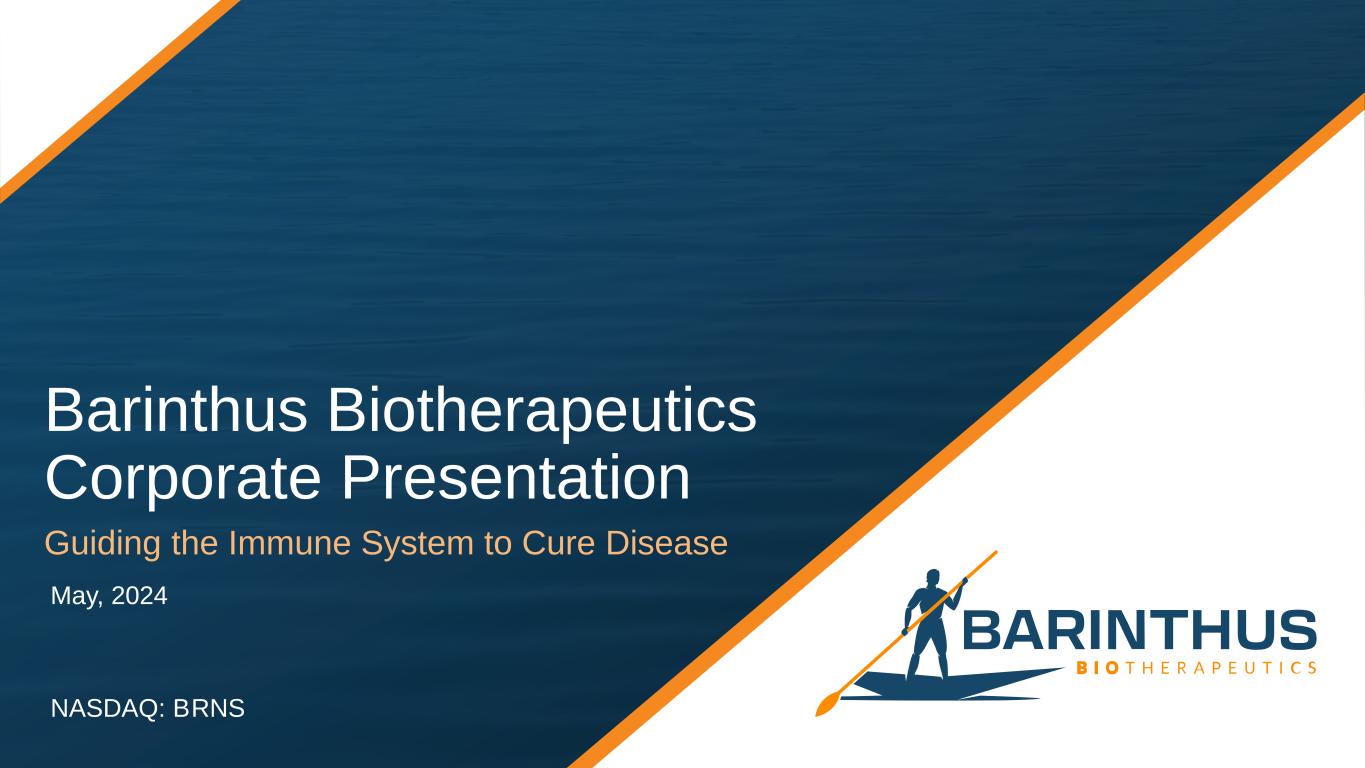
Barinthus Biotherapeutics Corporate Presentation Guiding the Immune System to Cure Disease May, 2024 NASDAQ: BRNS
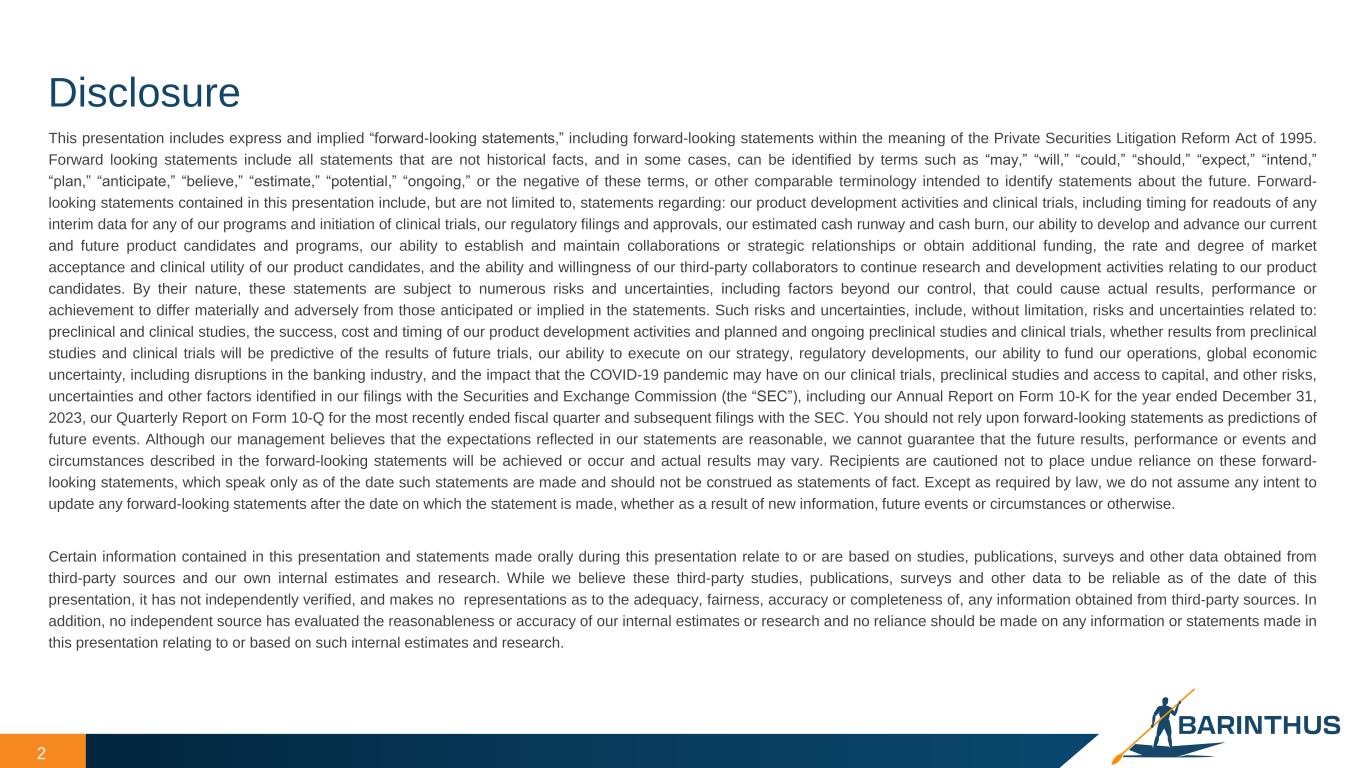
Disclosure 2 This presentation includes express and implied “forward-looking statements,” including forward-looking statements within the meaning of the Private Securities Litigation Reform Act of 1995. Forward looking statements include all statements that are not historical facts, and in some cases, can be identified by terms such as “may,” “will,” “could,” “should,” “expect,” “intend,” “plan,” “anticipate,” “believe,” “estimate,” “potential,” “ongoing,” or the negative of these terms, or other comparable terminology intended to identify statements about the future. Forward- looking statements contained in this presentation include, but are not limited to, statements regarding: our product development activities and clinical trials, including timing for readouts of any interim data for any of our programs and initiation of clinical trials, our regulatory filings and approvals, our estimated cash runway and cash burn, our ability to develop and advance our current and future product candidates and programs, our ability to establish and maintain collaborations or strategic relationships or obtain additional funding, the rate and degree of market acceptance and clinical utility of our product candidates, and the ability and willingness of our third-party collaborators to continue research and development activities relating to our product candidates. By their nature, these statements are subject to numerous risks and uncertainties, including factors beyond our control, that could cause actual results, performance or achievement to differ materially and adversely from those anticipated or implied in the statements. Such risks and uncertainties, include, without limitation, risks and uncertainties related to: preclinical and clinical studies, the success, cost and timing of our product development activities and planned and ongoing preclinical studies and clinical trials, whether results from preclinical studies and clinical trials will be predictive of the results of future trials, our ability to execute on our strategy, regulatory developments, our ability to fund our operations, global economic uncertainty, including disruptions in the banking industry, and the impact that the COVID-19 pandemic may have on our clinical trials, preclinical studies and access to capital, and other risks, uncertainties and other factors identified in our filings with the Securities and Exchange Commission (the “SEC”), including our Annual Report on Form 10-K for the year ended December 31, 2023, our Quarterly Report on Form 10-Q for the most recently ended fiscal quarter and subsequent filings with the SEC. You should not rely upon forward-looking statements as predictions of future events. Although our management believes that the expectations reflected in our statements are reasonable, we cannot guarantee that the future results, performance or events and circumstances described in the forward-looking statements will be achieved or occur and actual results may vary. Recipients are cautioned not to place undue reliance on these forward- looking statements, which speak only as of the date such statements are made and should not be construed as statements of fact. Except as required by law, we do not assume any intent to update any forward-looking statements after the date on which the statement is made, whether as a result of new information, future events or circumstances or otherwise. Certain information contained in this presentation and statements made orally during this presentation relate to or are based on studies, publications, surveys and other data obtained from third-party sources and our own internal estimates and research. While we believe these third-party studies, publications, surveys and other data to be reliable as of the date of this presentation, it has not independently verified, and makes no representations as to the adequacy, fairness, accuracy or completeness of, any information obtained from third-party sources. In addition, no independent source has evaluated the reasonableness or accuracy of our internal estimates or research and no reliance should be made on any information or statements made in this presentation relating to or based on such internal estimates and research.
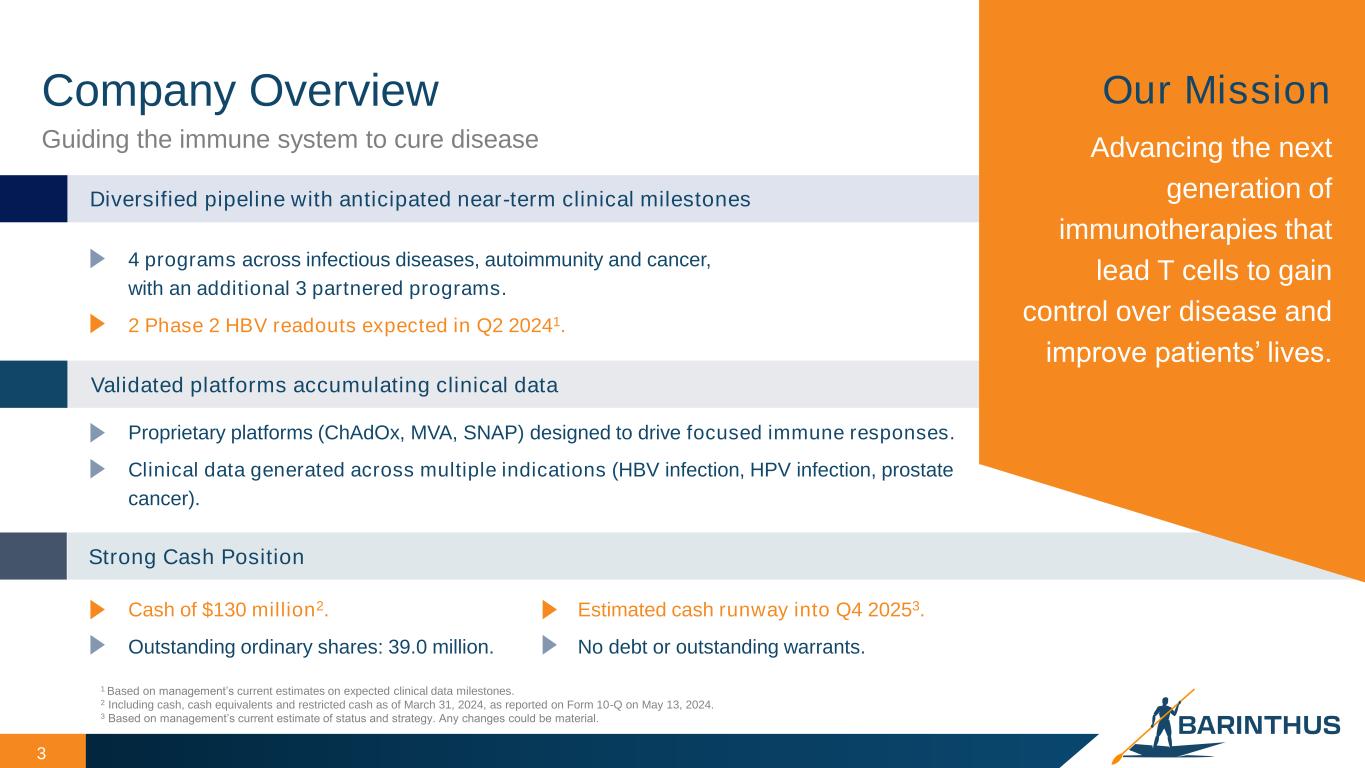
Company Overview 3 Cash of $130 million2. Outstanding ordinary shares: 39.0 million. Estimated cash runway into Q4 20253. No debt or outstanding warrants. Strong Cash Position Diversified pipeline with anticipated near-term clinical milestones 4 programs across infectious diseases, autoimmunity and cancer, with an additional 3 partnered programs. 2 Phase 2 HBV readouts expected in Q2 20241. Proprietary platforms (ChAdOx, MVA, SNAP) designed to drive focused immune responses. Clinical data generated across multiple indications (HBV infection, HPV infection, prostate cancer). Validated platforms accumulating clinical data Guiding the immune system to cure disease Our Mission Advancing the next generation of immunotherapies that lead T cells to gain control over disease and improve patients’ lives. 1 Based on management’s current estimates on expected clinical data milestones. 2 Including cash, cash equivalents and restricted cash as of March 31, 2024, as reported on Form 10-Q on May 13, 2024. 3 Based on management’s current estimate of status and strategy. Any changes could be material.
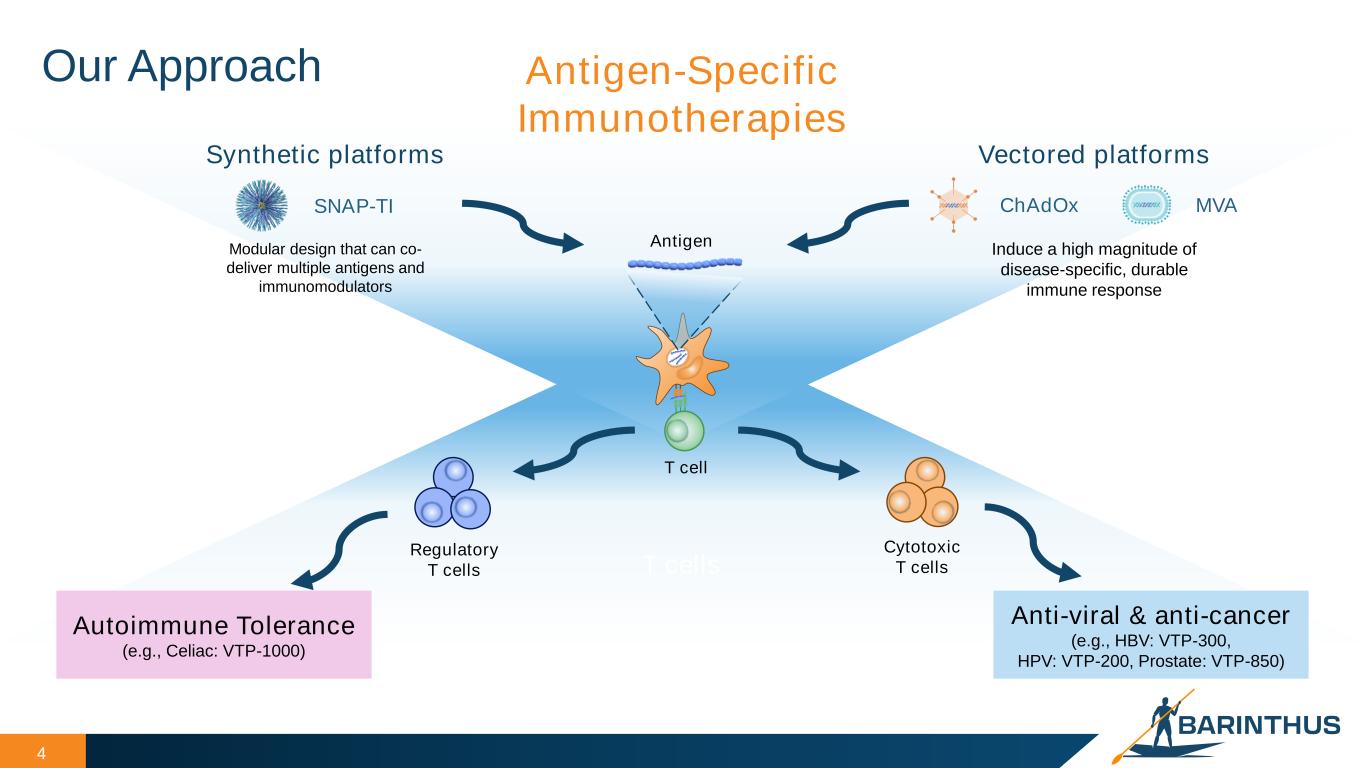
T cells Our Approach 4 Antigen-Specific Immunotherapies Cytotoxic T cells Regulatory T cells Autoimmune Tolerance (e.g., Celiac: VTP-1000) Anti-viral & anti-cancer (e.g., HBV: VTP-300, HPV: VTP-200, Prostate: VTP-850) Antigen Synthetic platforms SNAP-TI Modular design that can co- deliver multiple antigens and immunomodulators Vectored platforms ChAdOx MVA Induce a high magnitude of disease-specific, durable immune response T cell
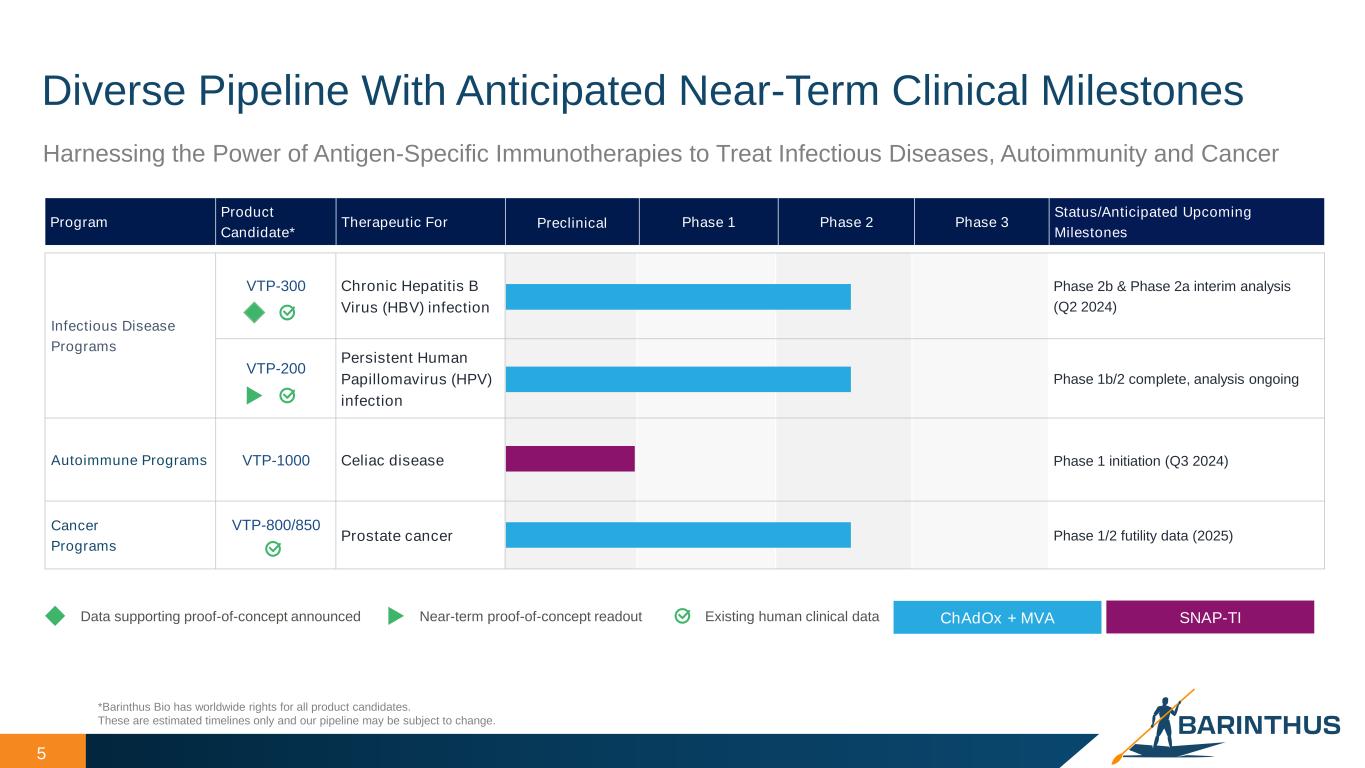
Infectious Disease Programs VTP-300 Chronic Hepatitis B Virus (HBV) infection Phase 2b & Phase 2a interim analysis (Q2 2024) VTP-200 Persistent Human Papillomavirus (HPV) infection Phase 1b/2 complete, analysis ongoing Autoimmune Programs VTP-1000 Celiac disease Phase 1 initiation (Q3 2024) Cancer Programs VTP-800/850 Prostate cancer Phase 1/2 futility data (2025) 5 Program Product Candidate* Therapeutic For Preclinical Phase 1 Phase 2 Phase 3 Status/Anticipated Upcoming Milestones Near-term proof-of-concept readout Existing human clinical dataData supporting proof-of-concept announced ChAdOx + MVA SNAP-TI Diverse Pipeline With Anticipated Near-Term Clinical Milestones *Barinthus Bio has worldwide rights for all product candidates. These are estimated timelines only and our pipeline may be subject to change. Harnessing the Power of Antigen-Specific Immunotherapies to Treat Infectious Diseases, Autoimmunity and Cancer
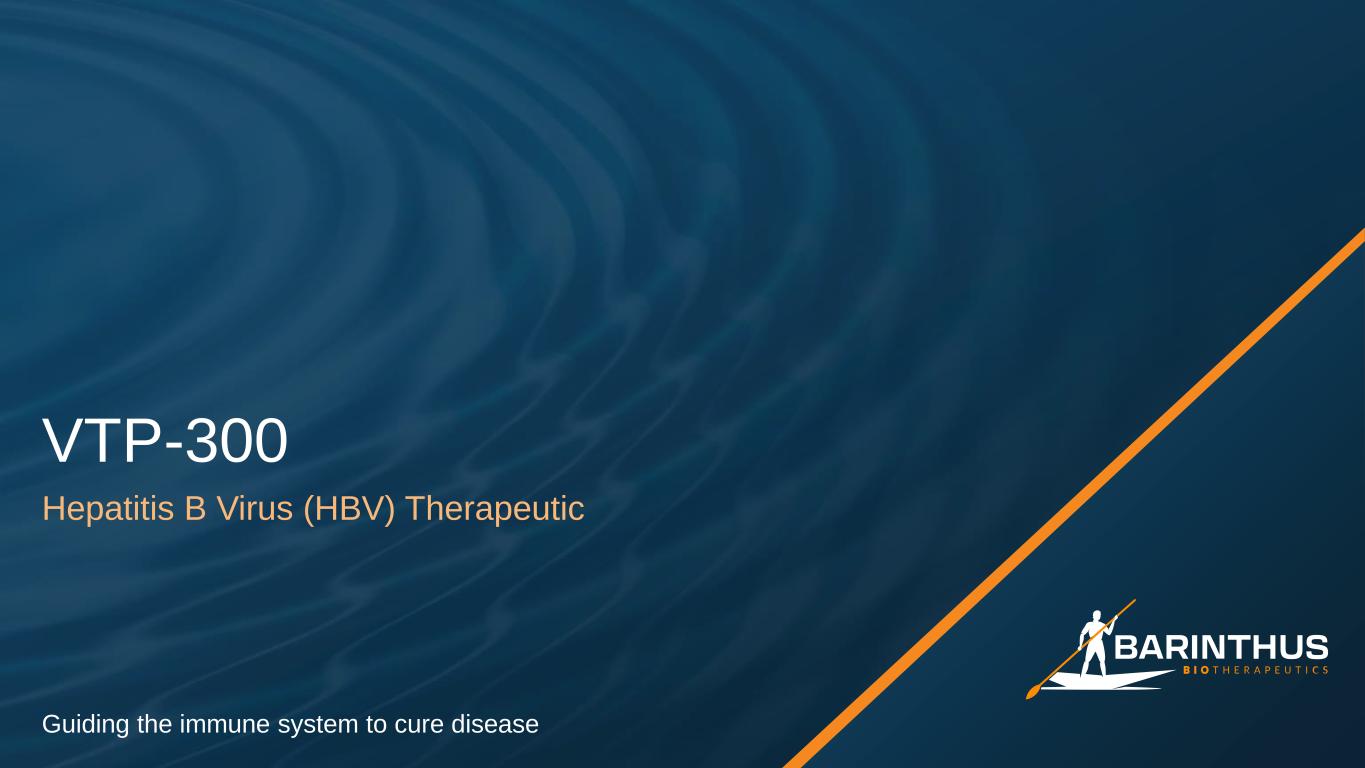
VTP-300 Hepatitis B Virus (HBV) Therapeutic Guiding the immune system to cure disease
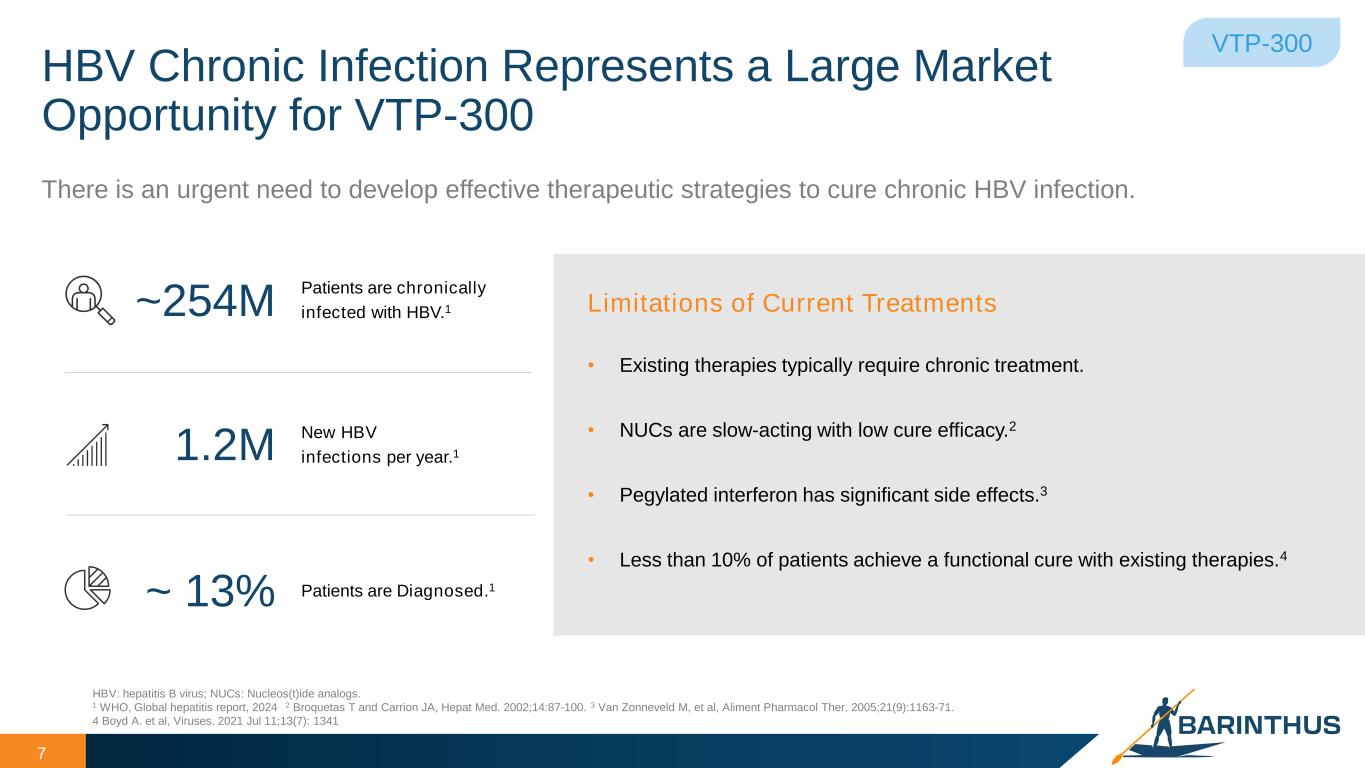
HBV Chronic Infection Represents a Large Market Opportunity for VTP-300 7 HBV: hepatitis B virus; NUCs: Nucleos(t)ide analogs. 1 WHO, Global hepatitis report, 2024. 2 Broquetas T and Carrion JA, Hepat Med. 2002;14:87-100. 3 Van Zonneveld M, et al, Aliment Pharmacol Ther. 2005;21(9):1163-71. 4 Boyd A. et al, Viruses. 2021 Jul 11;13(7): 1341 • Existing therapies typically require chronic treatment. • NUCs are slow-acting with low cure efficacy.2 • Pegylated interferon has significant side effects.3 • Less than 10% of patients achieve a functional cure with existing therapies.4 Limitations of Current Treatments Patients are chronically infected with HBV.1~254M New HBV infections per year.11.2M Patients are Diagnosed.1~ 13% VTP-300 There is an urgent need to develop effective therapeutic strategies to cure chronic HBV infection.
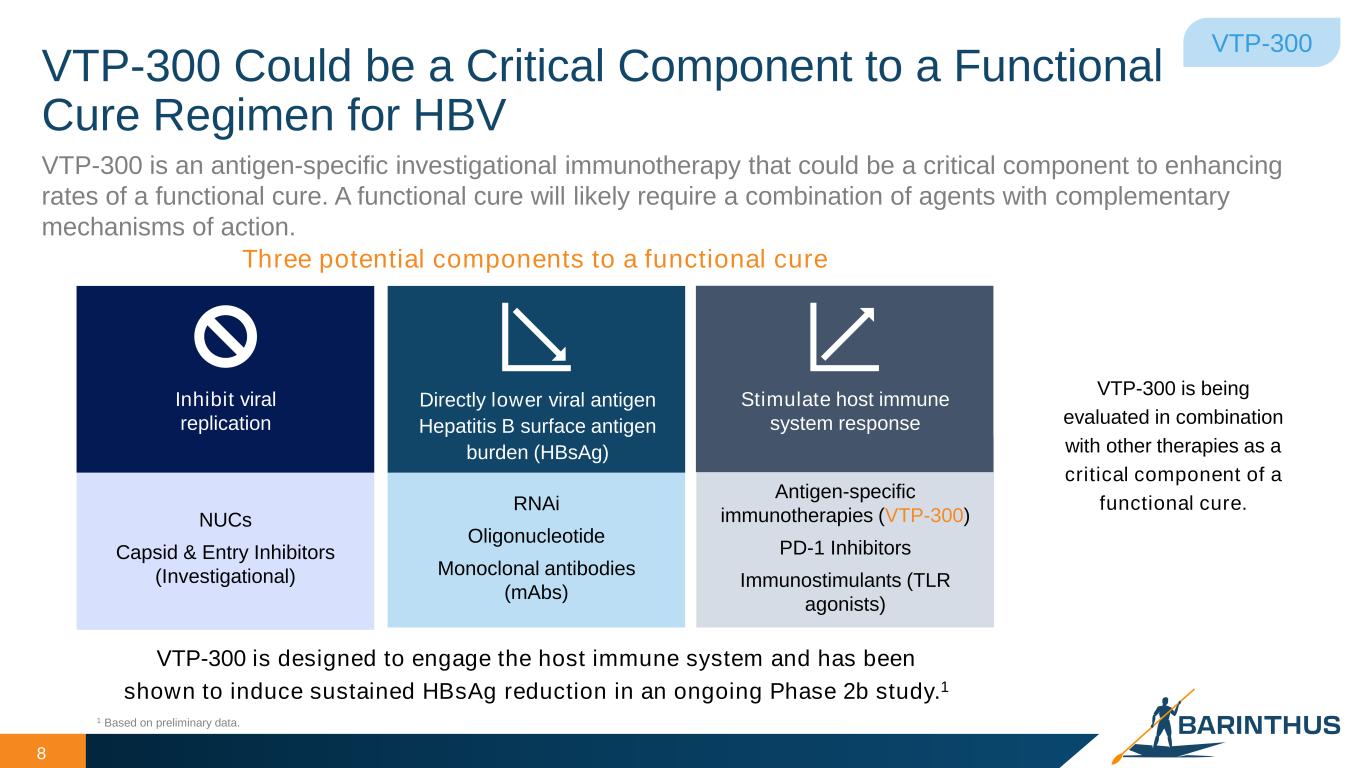
VTP-300 Could be a Critical Component to a Functional Cure Regimen for HBV 8 VTP-300 is designed to engage the host immune system and has been shown to induce sustained HBsAg reduction in an ongoing Phase 2b study.1 VTP-300 is being evaluated in combination with other therapies as a critical component of a functional cure. VTP-300 VTP-300 is an antigen-specific investigational immunotherapy that could be a critical component to enhancing rates of a functional cure. A functional cure will likely require a combination of agents with complementary mechanisms of action. Three potential components to a functional cure NUCs Capsid & Entry Inhibitors (Investigational) Inhibit viral replication RNAi Oligonucleotide Monoclonal antibodies (mAbs) Directly lower viral antigen Hepatitis B surface antigen burden (HBsAg) Antigen-specific immunotherapies (VTP-300) PD-1 Inhibitors Immunostimulants (TLR agonists) Stimulate host immune system response 1 Based on preliminary data.
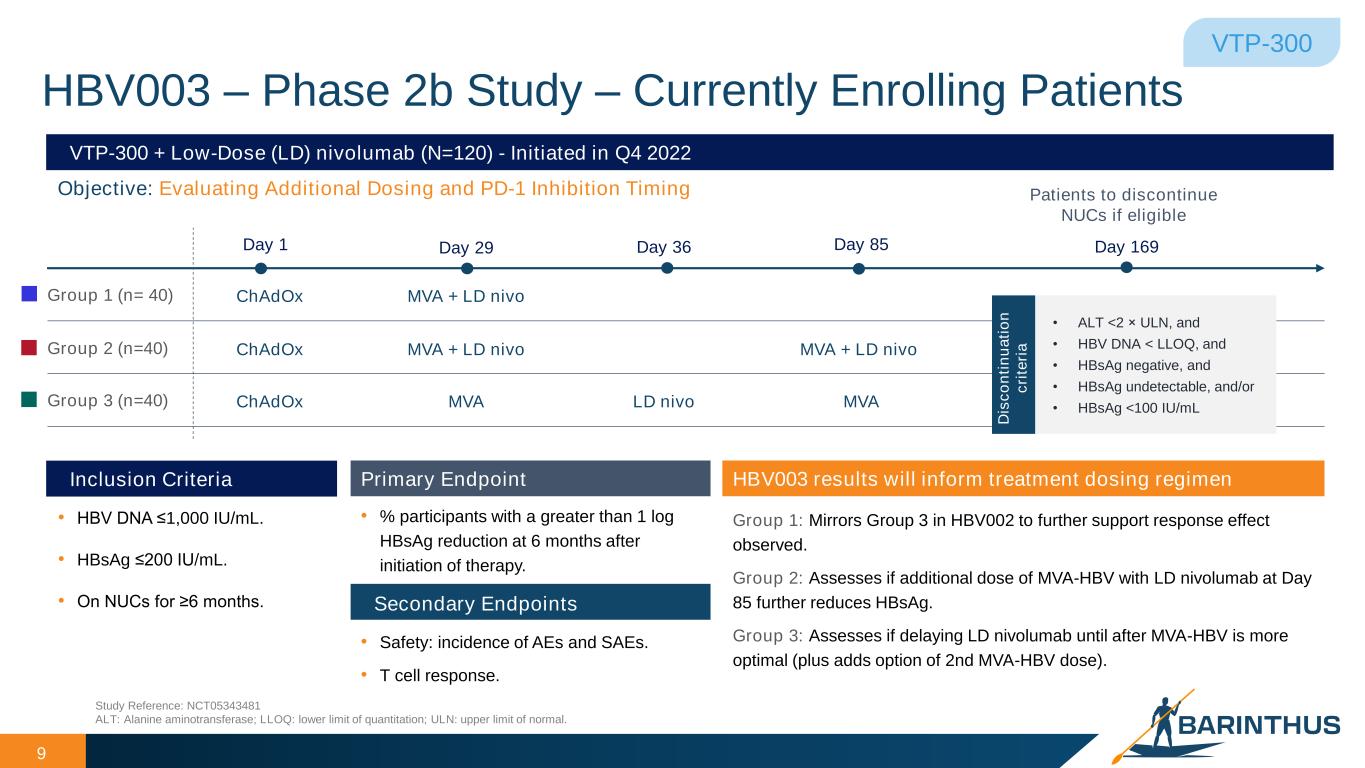
HBV003 – Phase 2b Study – Currently Enrolling Patients Inclusion Criteria • HBV DNA ≤1,000 IU/mL. • HBsAg ≤200 IU/mL. • On NUCs for ≥6 months. Primary Endpoint • % participants with a greater than 1 log HBsAg reduction at 6 months after initiation of therapy. Secondary Endpoints • Safety: incidence of AEs and SAEs. • T cell response. HBV003 results will inform treatment dosing regimen Group 1: Mirrors Group 3 in HBV002 to further support response effect observed. Group 2: Assesses if additional dose of MVA-HBV with LD nivolumab at Day 85 further reduces HBsAg. Group 3: Assesses if delaying LD nivolumab until after MVA-HBV is more optimal (plus adds option of 2nd MVA-HBV dose). VTP-300 + Low-Dose (LD) nivolumab (N=120) - Initiated in Q4 2022 Objective: Evaluating Additional Dosing and PD-1 Inhibition Timing MVA + LD nivo Day 1 Group 1 (n= 40) Group 2 (n=40) Group 3 (n=40) ChAdOx Day 29 Day 36 Day 85 ChAdOx ChAdOx MVA + LD nivo MVA MVA + LD nivo LD nivo MVA Day 169 Patients to discontinue NUCs if eligible • ALT <2 × ULN, and • HBV DNA < LLOQ, and • HBsAg negative, and • HBsAg undetectable, and/or • HBsAg <100 IU/mL D is c o n ti n u a ti o n c ri te ri a 9 Study Reference: NCT05343481 ALT: Alanine aminotransferase; LLOQ: lower limit of quantitation; ULN: upper limit of normal. VTP-300
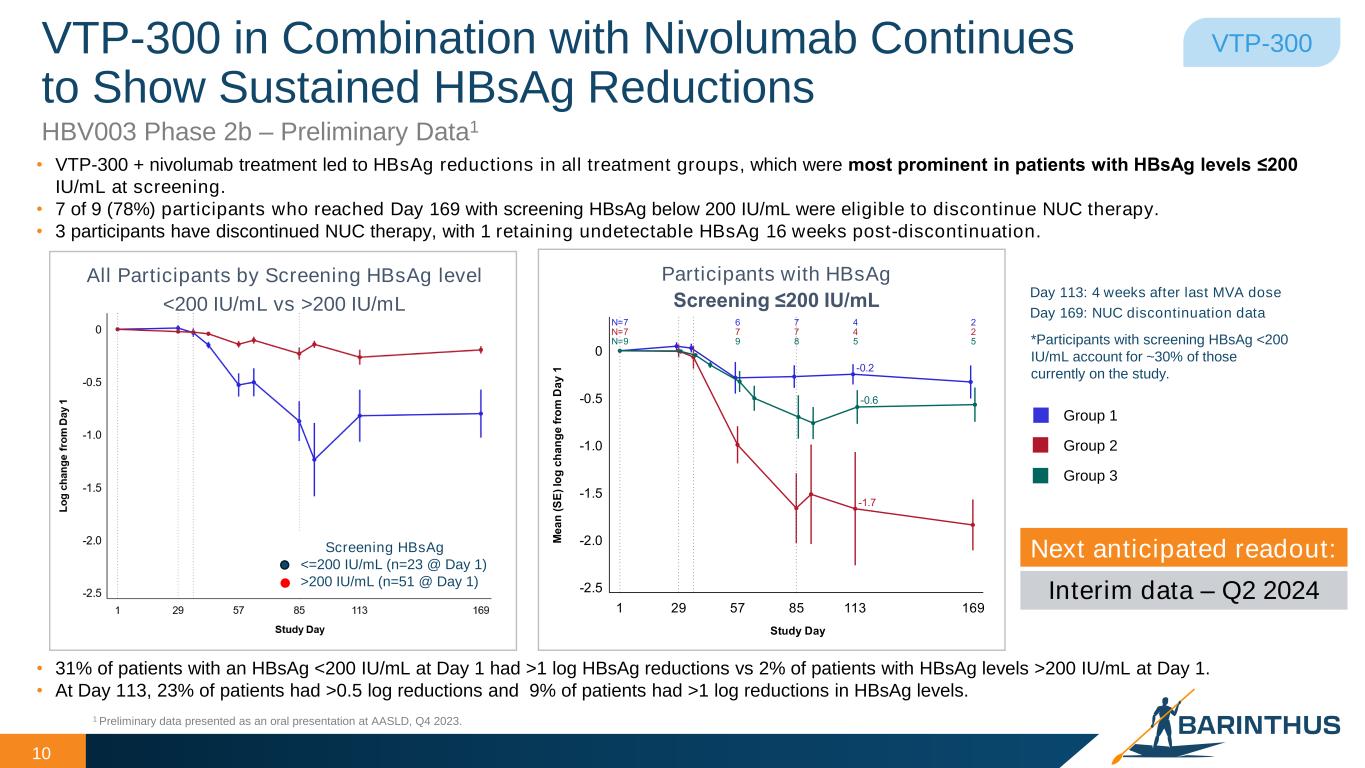
10 VTP-300 in Combination with Nivolumab Continues to Show Sustained HBsAg Reductions 0.2 . 0.6 N 6 2 N 2 N 2 6 2. 2.0 . .0 0. 0 Participants with HBsAg i ≤200 IU/ L Day 113: 4 weeks after last MVA dose Day 169: NUC discontinuation data • VTP-300 + nivolumab treatment led to HBsAg reductions in all treatment groups, which were s p i i p i s wi HBsA v s ≤200 IU/mL at screening. • 7 of 9 (78%) participants who reached Day 169 with screening HBsAg below 200 IU/mL were eligible to discontinue NUC therapy. • 3 participants have discontinued NUC therapy, with 1 retaining undetectable HBsAg 16 weeks post-discontinuation. *Participants with screening HBsAg <200 IU/mL account for ~30% of those currently on the study. 1 Preliminary data presented as an oral presentation at AASLD, Q4 2023. Group 1 Group 2 Group 3 All Participants by Screening HBsAg level <200 IU/mL vs >200 IU/mL Screening HBsAg • <=200 IU/mL (n=23 @ Day 1) • >200 IU/mL (n=51 @ Day 1) VTP-300 HBV003 Phase 2b – Preliminary Data1 Next anticipated readout: Interim data – Q2 2024 • 31% of patients with an HBsAg <200 IU/mL at Day 1 had >1 log HBsAg reductions vs 2% of patients with HBsAg levels >200 IU/mL at Day 1. • At Day 113, 23% of patients had >0.5 log reductions and 9% of patients had >1 log reductions in HBsAg levels.
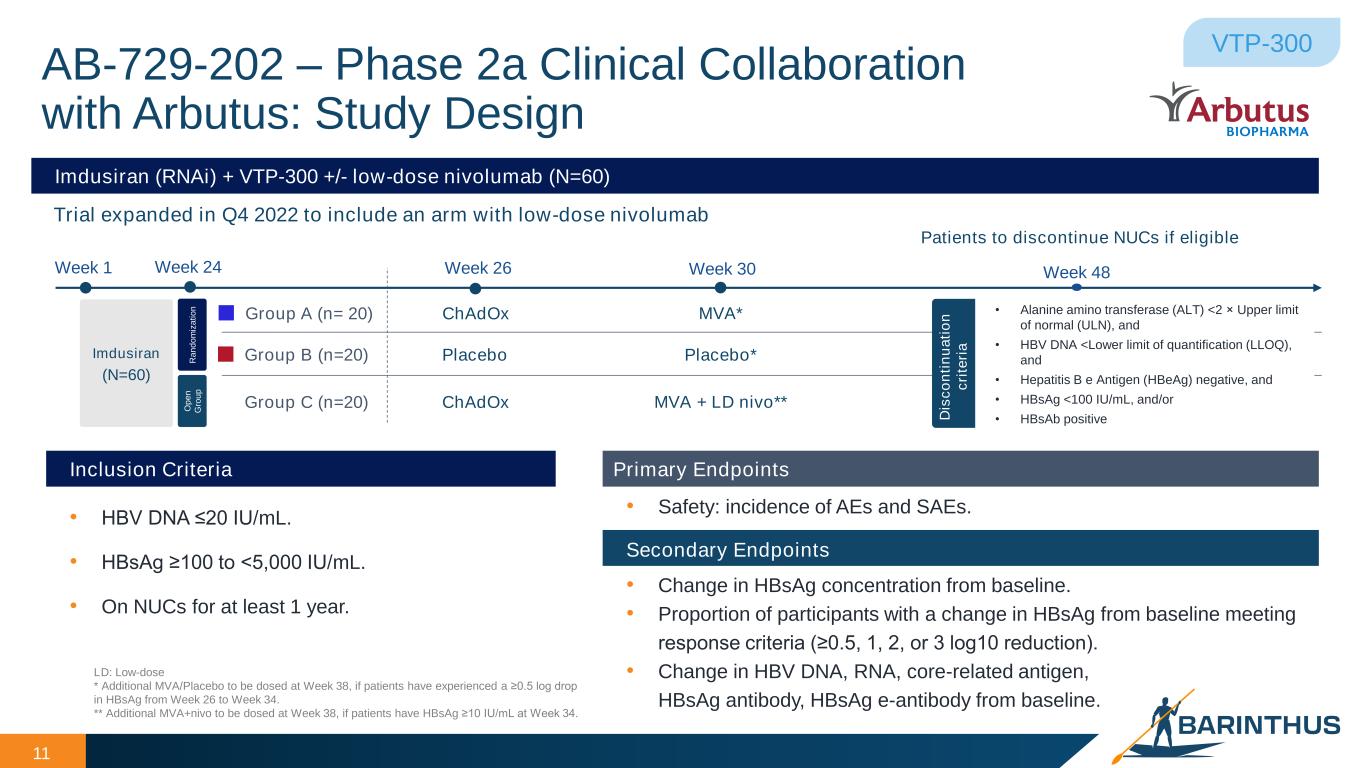
• HBV DNA ≤20 IU/mL. • HBsAg ≥ 00 to < ,000 IU/mL. • On NUCs for at least 1 year. Inclusion Criteria Primary Endpoints Secondary Endpoints • Safety: incidence of AEs and SAEs. • Change in HBsAg concentration from baseline. • Proportion of participants with a change in HBsAg from baseline meeting response criteria (≥0. , , 2, or log 0 reduction). • Change in HBV DNA, RNA, core-related antigen, HBsAg antibody, HBsAg e-antibody from baseline. Imdusiran (RNAi) + VTP-300 +/- low-dose nivolumab (N=60) Trial expanded in Q4 2022 to include an arm with low-dose nivolumab 11 LD: Low-dose * Additional MVA/Placebo to be dosed at Week 38, if patients have experienced a ≥0. log drop in HBsAg from Week 26 to Week 34. ** Additional MVA+nivo to be dosed at Week 38, if patients have HBsAg ≥ 0 IU/mL at Week . Imdusiran (N=60) R a n d o m iz a ti o n O p e n G ro u p AB-729-202 – Phase 2a Clinical Collaboration with Arbutus: Study Design VTP-300 Week 1 Group A (n= 20) Group B (n=20) Week 24 Week 26 Week 48 ChAdOx Placebo Group C (n=20) ChAdOx Week 30 MVA + LD nivo** MVA* Placebo* Patients to discontinue NUCs if eligible • Alanine amino transferase (ALT) <2 × Upper limit of normal (ULN), and • HBV DNA <Lower limit of quantification (LLOQ), and • Hepatitis B e Antigen (HBeAg) negative, and • HBsAg <100 IU/mL, and/or • HBsAb positiveD is c o n ti n u a ti o n c ri te ri a
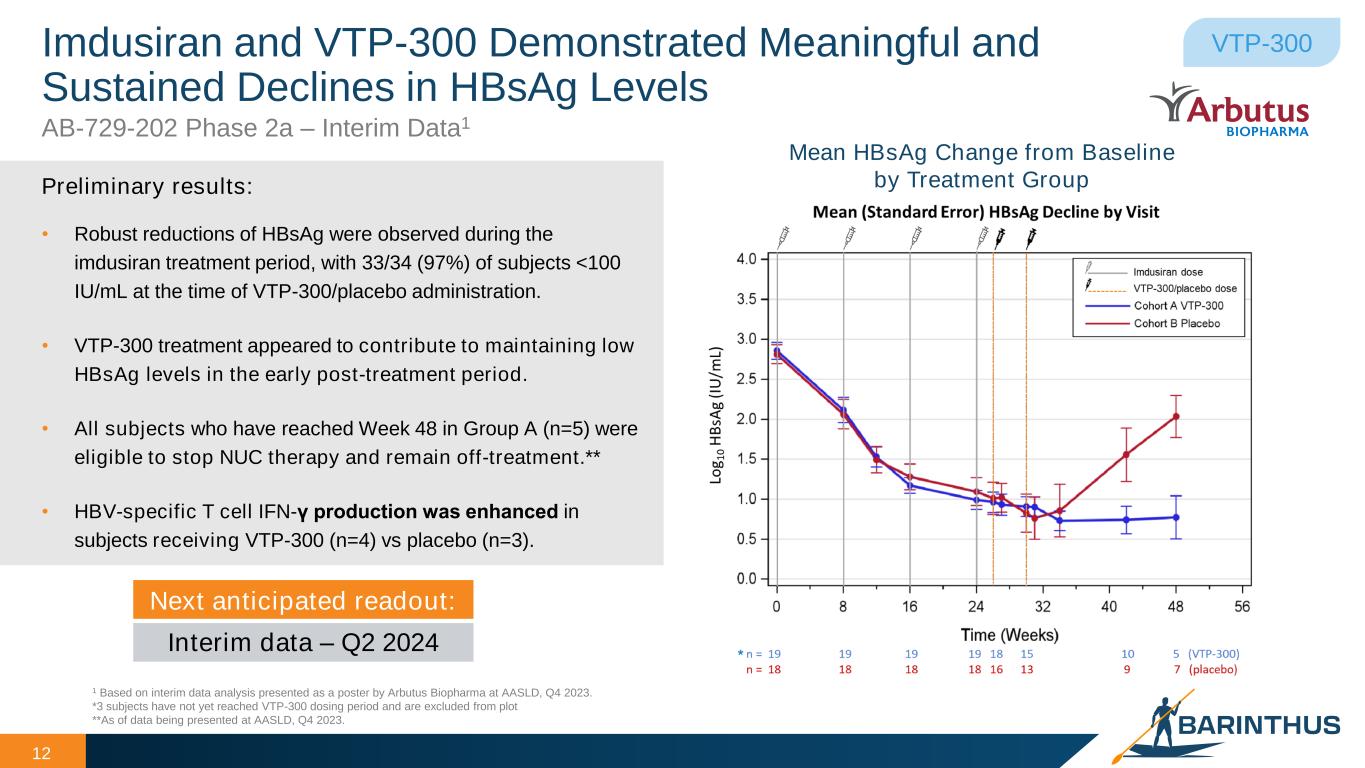
Imdusiran and VTP-300 Demonstrated Meaningful and Sustained Declines in HBsAg Levels 12 Mean HBsAg Change from Baseline by Treatment GroupPreliminary results: • Robust reductions of HBsAg were observed during the imdusiran treatment period, with 33/34 (97%) of subjects <100 IU/mL at the time of VTP-300/placebo administration. • VTP-300 treatment appeared to contribute to maintaining low HBsAg levels in the early post-treatment period. • All subjects who have reached Week 48 in Group A (n=5) were eligible to stop NUC therapy and remain off-treatment.** • HBV-specific T cell IFN-γ p i w s in subjects receiving VTP-300 (n=4) vs placebo (n=3). 1 Based on interim data analysis presented as a poster by Arbutus Biopharma at AASLD, Q4 2023. *3 subjects have not yet reached VTP-300 dosing period and are excluded from plot **As of data being presented at AASLD, Q4 2023. VTP-300 AB-729-202 Phase 2a – Interim Data1 Next anticipated readout: Interim data – Q2 2024

VTP-200 Human Papillomavirus (HPV) Therapeutic Guiding the immune system to cure disease
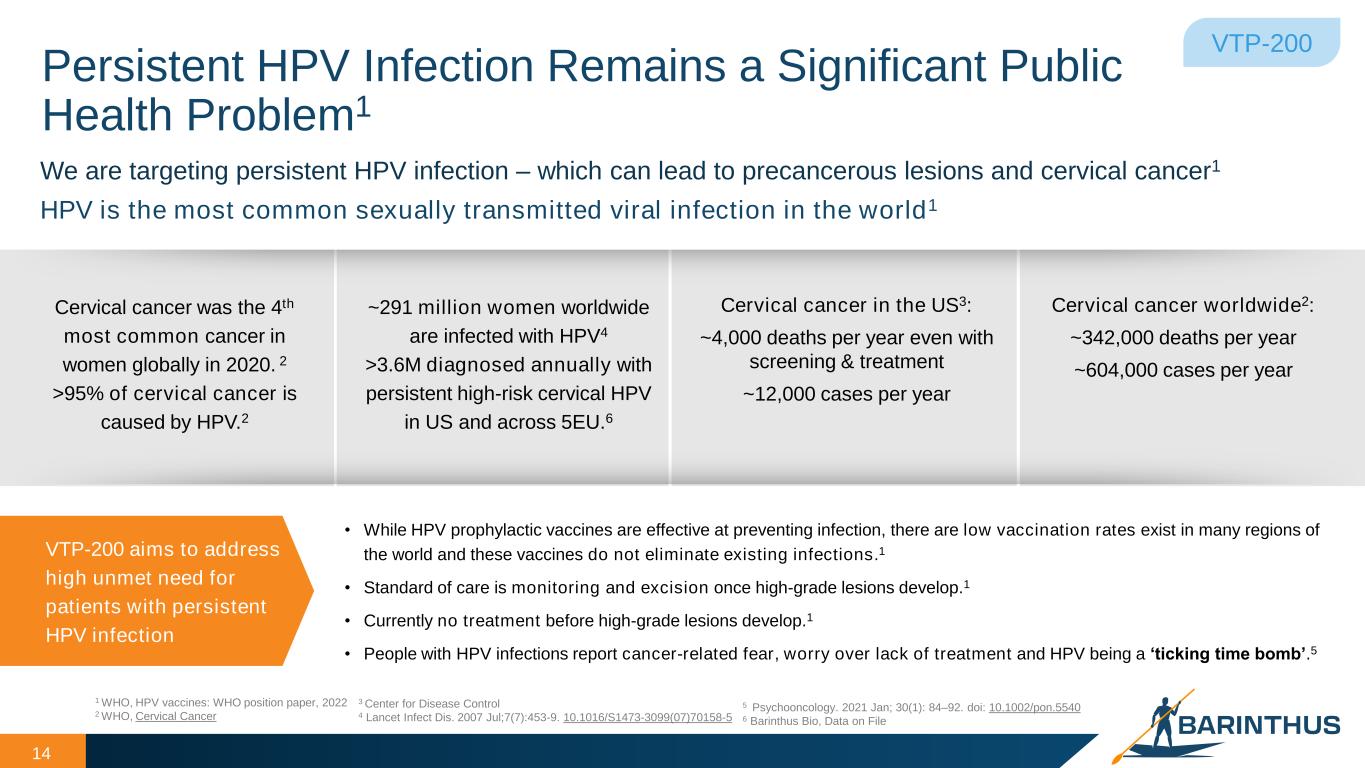
Persistent HPV Infection Remains a Significant Public Health Problem1 14 We are targeting persistent HPV infection – which can lead to precancerous lesions and cervical cancer1 HPV is the most common sexually transmitted viral infection in the world1 1 WHO, HPV vaccines: WHO position paper, 2022 2 WHO, Cervical Cancer 3 Center for Disease Control 4 Lancet Infect Dis. 2007 Jul;7(7):453-9. 10.1016/S1473-3099(07)70158-5 5 Psychooncology. 2021 Jan; 30(1): 84–92. doi: 10.1002/pon.5540 6 Barinthus Bio, Data on File • While HPV prophylactic vaccines are effective at preventing infection, there are low vaccination rates exist in many regions of the world and these vaccines do not eliminate existing infections.1 • Standard of care is monitoring and excision once high-grade lesions develop.1 • Currently no treatment before high-grade lesions develop.1 • People with HPV infections report cancer-related fear, worry over lack of treatment and HPV being a ‘ i ki i b b’.5 VTP-200 aims to address high unmet need for patients with persistent HPV infection VTP-200 Cervical cancer was the 4th most common cancer in women globally in 2020. 2 >95% of cervical cancer is caused by HPV.2 ~291 million women worldwide are infected with HPV4 >3.6M diagnosed annually with persistent high-risk cervical HPV in US and across 5EU.6 Cervical cancer in the US3: ~4,000 deaths per year even with screening & treatment ~12,000 cases per year Cervical cancer worldwide2: ~342,000 deaths per year ~604,000 cases per year
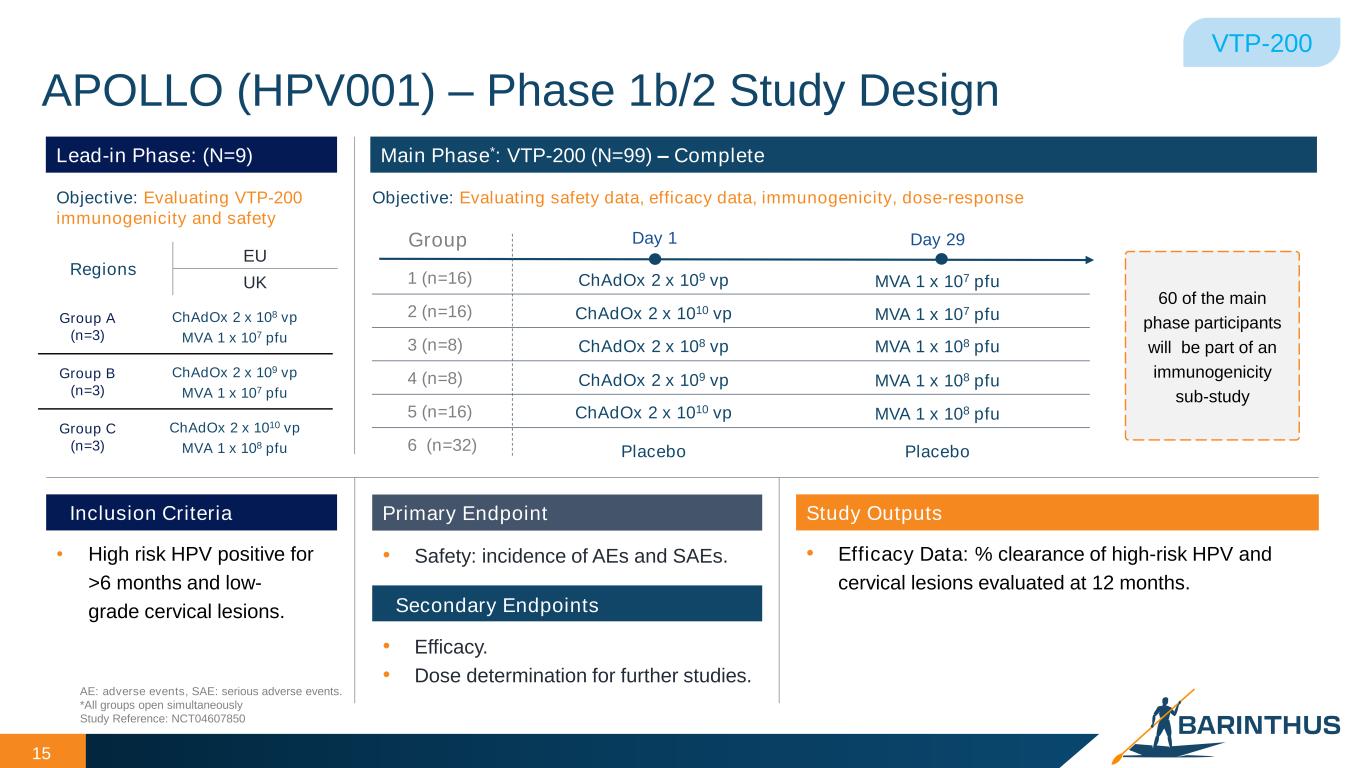
APOLLO (HPV001) – Phase 1b/2 Study Design 15 Inclusion Criteria • High risk HPV positive for >6 months and low- grade cervical lesions. Study Outputs • Efficacy Data: % clearance of high-risk HPV and cervical lesions evaluated at 12 months. Lead-in Phase: (N=9) Objective: Evaluating VTP-200 immunogenicity and safety Group A (n=3) ChAdOx 2 x 108 vp MVA 1 x 107 pfu Group B (n=3) ChAdOx 2 x 109 vp MVA 1 x 107 pfu Group C (n=3) ChAdOx 2 x 1010 vp MVA 1 x 108 pfu Regions EU UK Main Phase*: VTP-200 (N=99) – Complete Objective: Evaluating safety data, efficacy data, immunogenicity, dose-response 1 (n=16) 2 (n=16) 3 (n=8) 4 (n=8) 5 (n=16) 6 (n=32) ChAdOx 2 x 109 vp MVA 1 x 107 pfu Day 1 ChAdOx 2 x 1010 vp ChAdOx 2 x 108 vp ChAdOx 2 x 109 vp ChAdOx 2 x 1010 vp Placebo MVA 1 x 107 pfu MVA 1 x 108 pfu MVA 1 x 108 pfu MVA 1 x 108 pfu Placebo Day 29Group 60 of the main phase participants will be part of an immunogenicity sub-study AE: adverse events, SAE: serious adverse events. *All groups open simultaneously Study Reference: NCT04607850 Primary Endpoint • Safety: incidence of AEs and SAEs. Secondary Endpoints • Efficacy. • Dose determination for further studies. VTP-200

16 APOLLO Trial Primary Endpoint Met - Analysis Ongoing AE: adverse events, SAE: serious adverse events. * in participants with both reported lesions at screening and visualization of the cervical transformation zone at 12 months (n=57). APOLLO (HPV001): Phase 1b/2 Topline Final Data • Primary endpoint met: VTP-200 was generally well- tolerated and administered with no treatment-related grade 3 or higher unsolicited AEs and no treatment-related SAEs. • In groups receiving the highest dose of ChAdOx: • Highest high-risk (hr)HPV clearance rate observed in Group 2. • Highest cervical lesion clearance rate observed in Groups 2 and 5. • Pooled data from the five active dose groups showed no significant improvement in hrHPV clearance or cervical lesion clearance rates in comparison to the placebo group. VTP-200 Next anticipated readout: Complete Analysis - Ongoing Month 12 hrHPV clearance Month 12 Cervical lesion clearance* Group 1 12% 40% 2 60% 67% 3 11% 20% 4 33% 33% 5 36% 67% Placebo 33% 39%
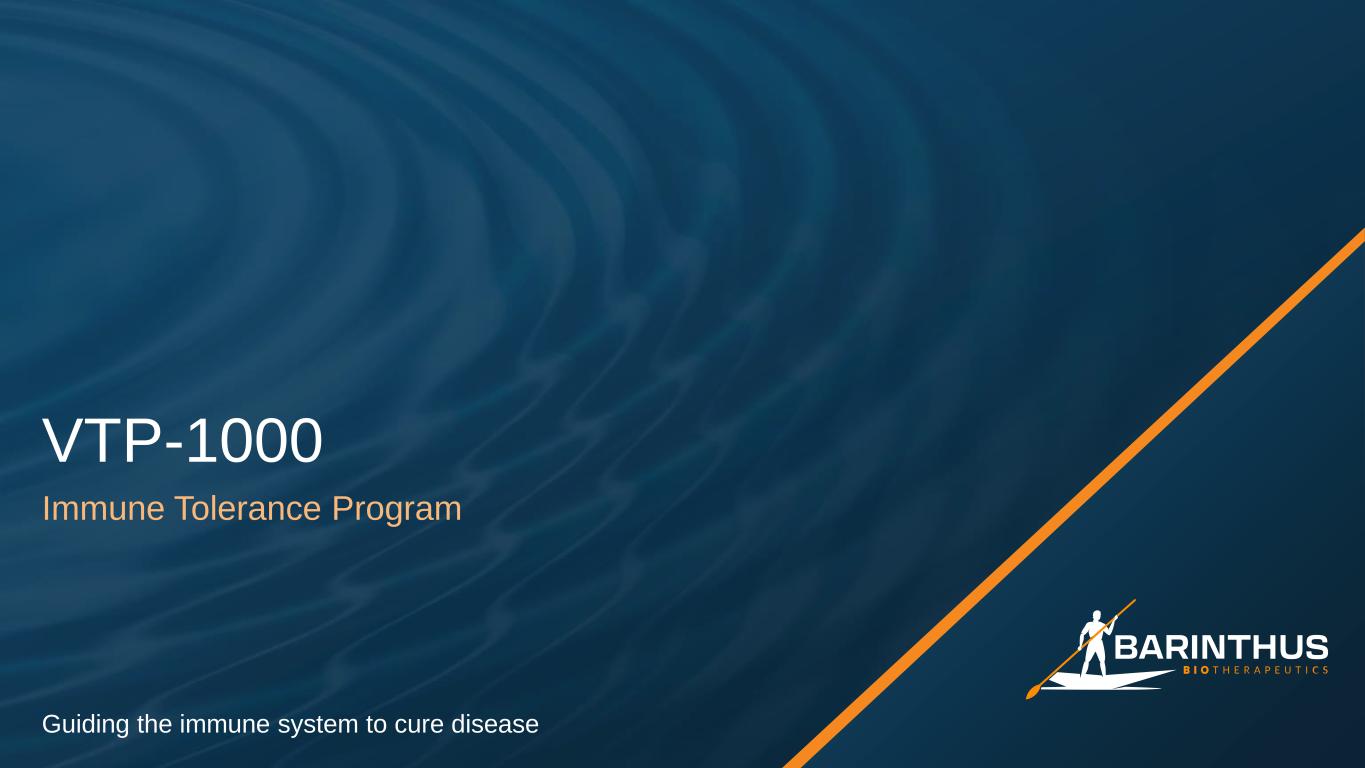
VTP-1000 Immune Tolerance Program Guiding the immune system to cure disease
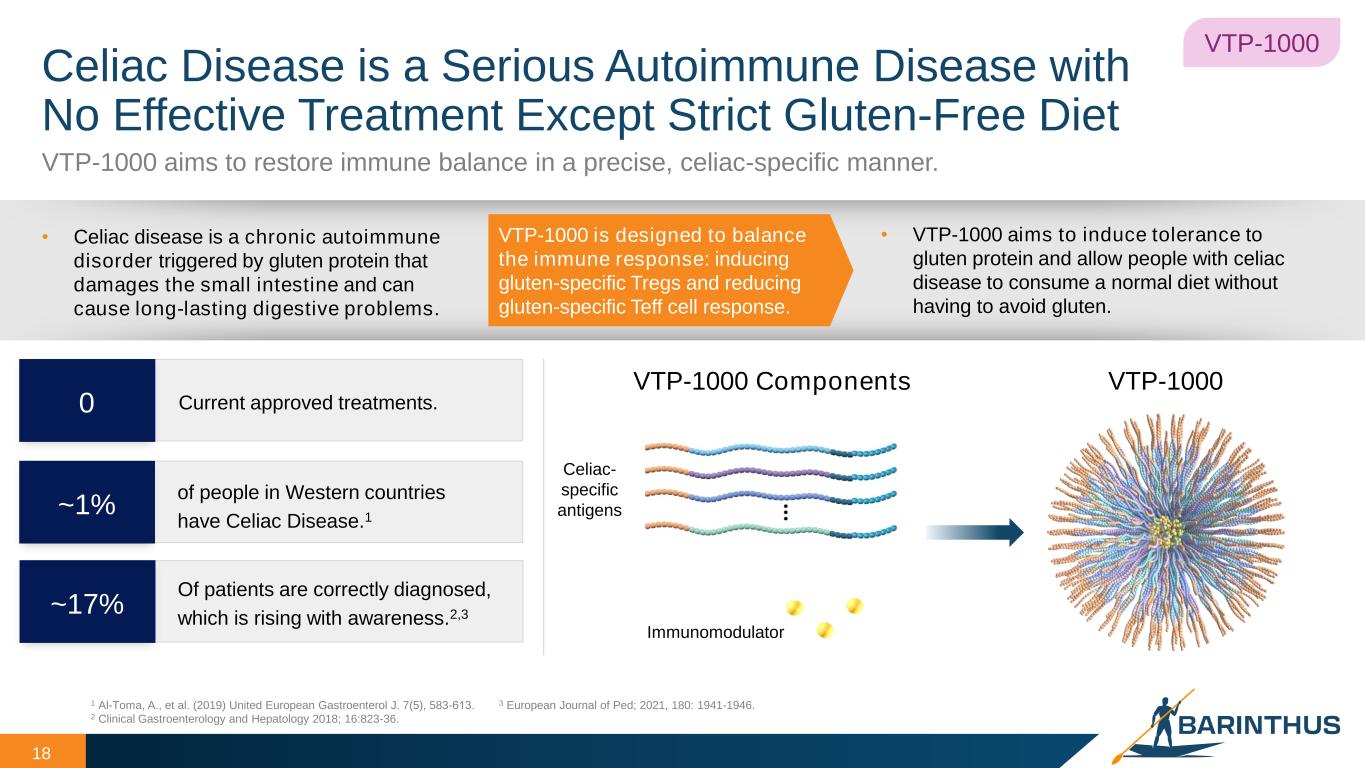
Celiac Disease is a Serious Autoimmune Disease with No Effective Treatment Except Strict Gluten-Free Diet 18 VTP-1000 VTP-1000 aims to restore immune balance in a precise, celiac-specific manner. of people in Western countries have Celiac Disease.1 ~1% Current approved treatments.0 Of patients are correctly diagnosed, which is rising with awareness.2,3~17% 1 Al-Toma, A., et al. (2019) United European Gastroenterol J. 7(5), 583-6 . 2 Clinical Gastroenterology and Hepatology 2018; 16:823-36. 3 European Journal of Ped; 2021, 180: 1941-1946. • Celiac disease is a chronic autoimmune disorder triggered by gluten protein that damages the small intestine and can cause long-lasting digestive problems. VTP-1000 is designed to balance the immune response: inducing gluten-specific Tregs and reducing gluten-specific Teff cell response. • VTP-1000 aims to induce tolerance to gluten protein and allow people with celiac disease to consume a normal diet without having to avoid gluten. VTP-1000VTP-1000 Components Immunomodulator Celiac- specific antigens
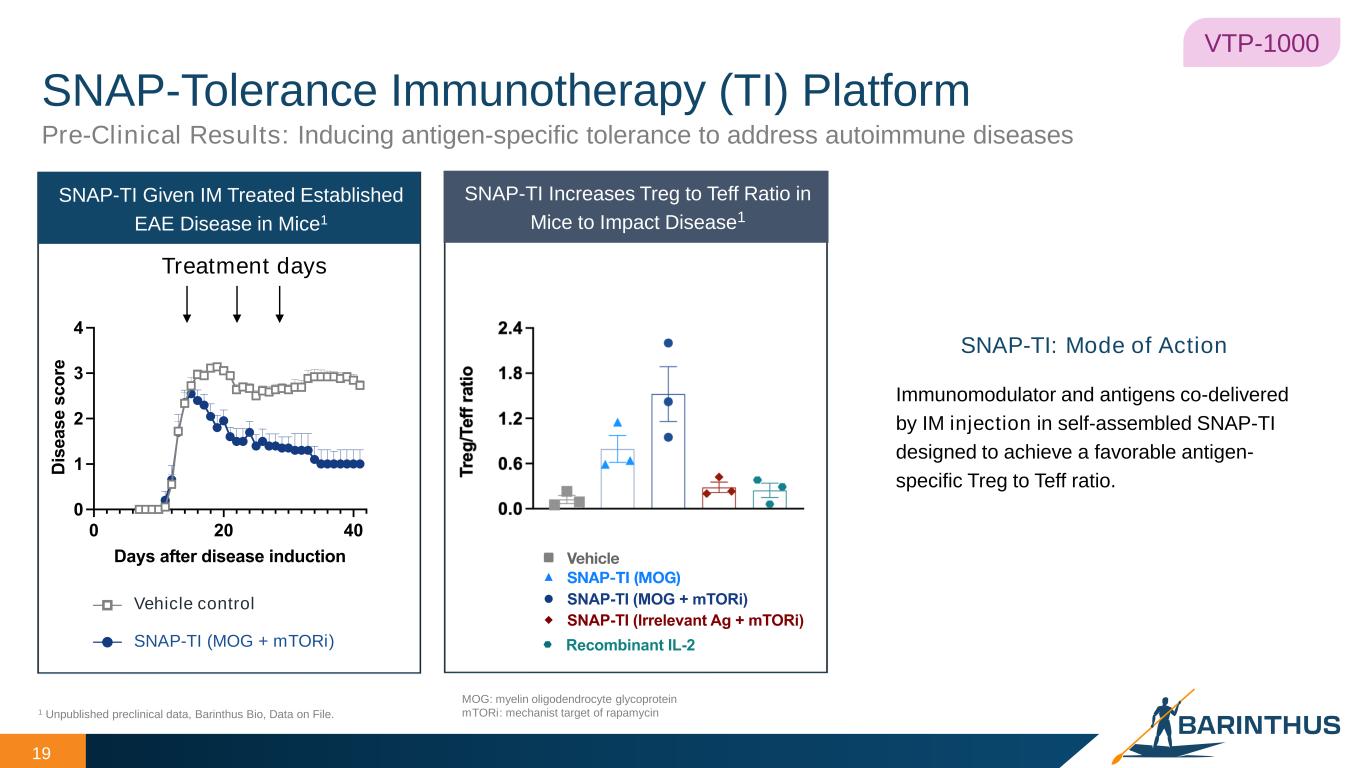
19 SNAP-Tolerance Immunotherapy (TI) Platform SNAP-TI Given IM Treated Established EAE Disease in Mice1 Immunomodulator and antigens co-delivered by IM injection in self-assembled SNAP-TI designed to achieve a favorable antigen- specific Treg to Teff ratio. SNAP-TI: Mode of Action 1 Unpublished preclinical data, Barinthus Bio, Data on File. 0 20 40 0 1 2 3 4 Days after disease induction D is e a s e s c o re Treatment days SNAP-TI Increases Treg to Teff Ratio in Mice to Impact Disease1 [1] Vehicle [6] SNAPvax TV MOG; Rapamycin; 40 nmol Vehicle control SNAP-TI (MOG + mTORi) MOG: myelin oligodendrocyte glycoprotein mTORi: mechanist target of rapamycin VTP-1000 Pre-Clinical Results: Inducing antigen-specific tolerance to address autoimmune diseases
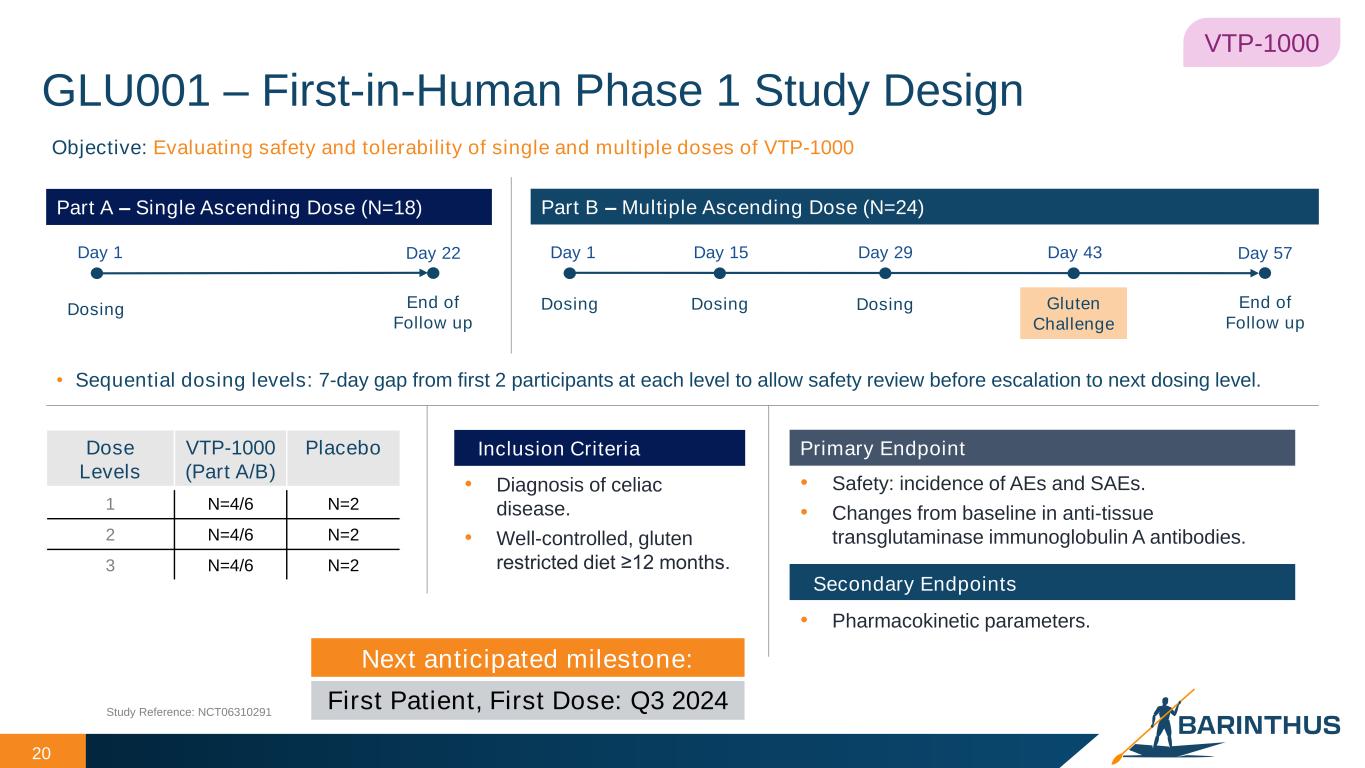
GLU001 – First-in-Human Phase 1 Study Design 20 Inclusion Criteria Part A – Single Ascending Dose (N=18) Part B – Multiple Ascending Dose (N=24) Primary Endpoint VTP-1000 Dose Levels VTP-1000 (Part A/B) Placebo 1 N=4/6 N=2 2 N=4/6 N=2 3 N=4/6 N=2 Objective: Evaluating safety and tolerability of single and multiple doses of VTP-1000 • Safety: incidence of AEs and SAEs. • Changes from baseline in anti-tissue transglutaminase immunoglobulin A antibodies. Secondary Endpoints • Pharmacokinetic parameters. • Diagnosis of celiac disease. • Well-controlled, gluten restricted diet ≥ 2 months. Study Reference: NCT06310291 Dosing End of Follow up Day 1 Day 22 Day 1 Day 57Day 15 Day 29 Day 43 Dosing Dosing Dosing End of Follow up Gluten Challenge • Sequential dosing levels: 7-day gap from first 2 participants at each level to allow safety review before escalation to next dosing level. Next anticipated milestone: First Patient, First Dose: Q3 2024
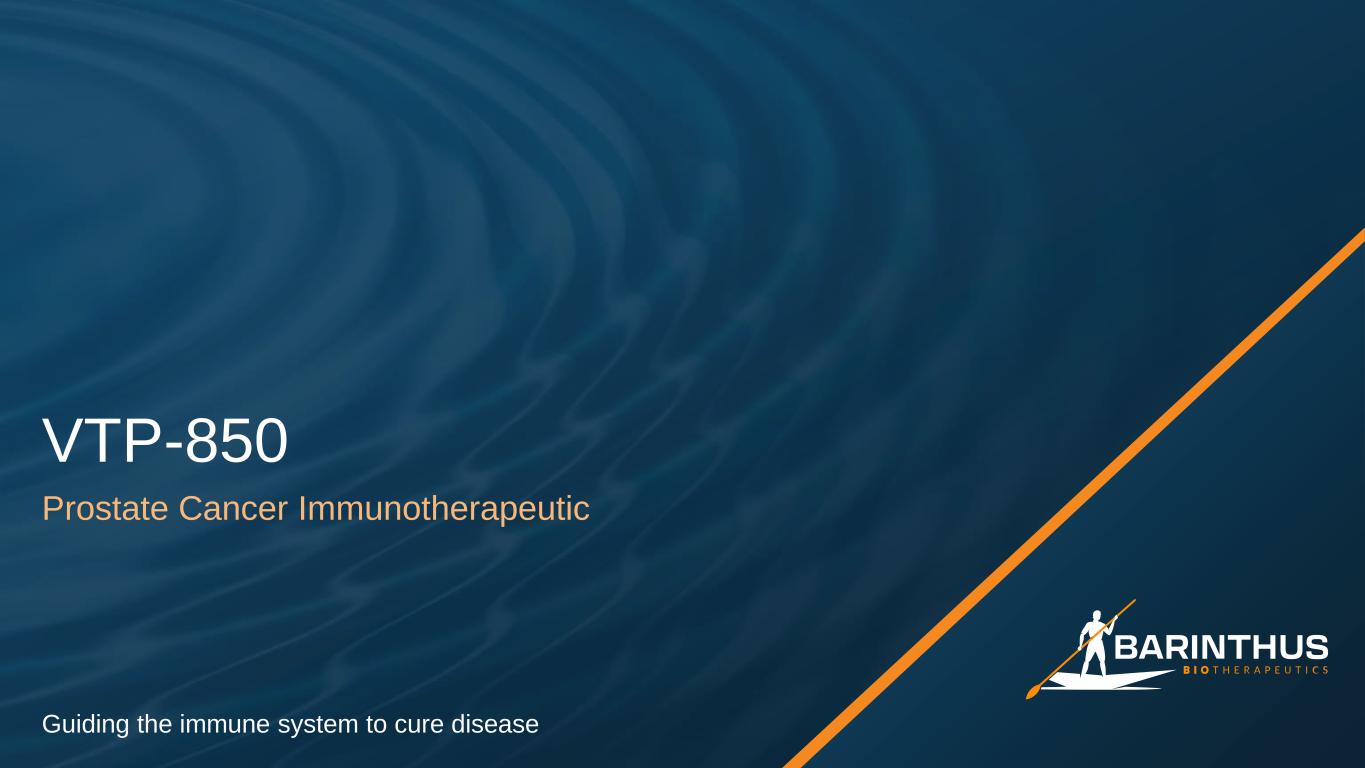
VTP-850 Prostate Cancer Immunotherapeutic Guiding the immune system to cure disease
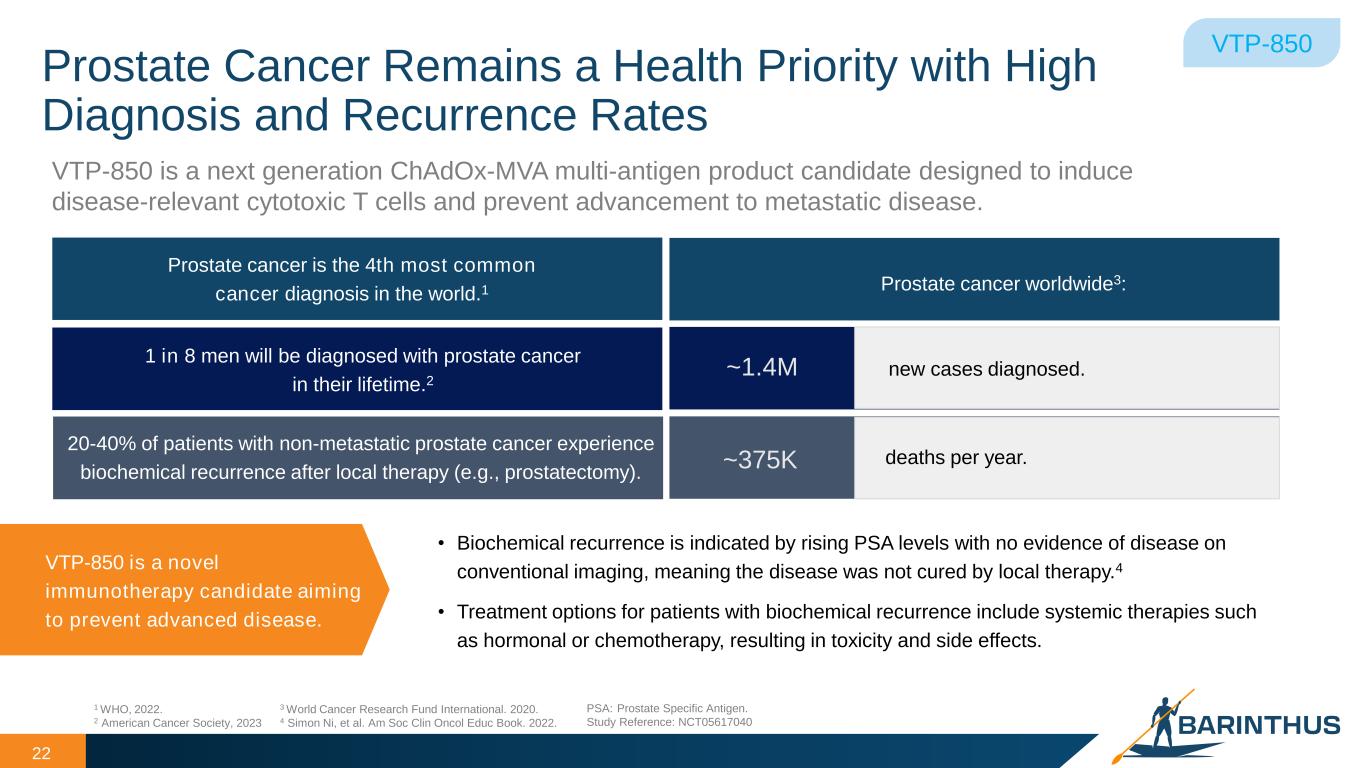
Prostate Cancer Remains a Health Priority with High Diagnosis and Recurrence Rates Prostate cancer is the 4th most common cancer diagnosis in the world.1 Prostate cancer worldwide3: 1 in 8 men will be diagnosed with prostate cancer in their lifetime.2 20-40% of patients with non-metastatic prostate cancer experience biochemical recurrence after local therapy (e.g., prostatectomy). ~1.4M ~375K • Biochemical recurrence is indicated by rising PSA levels with no evidence of disease on conventional imaging, meaning the disease was not cured by local therapy.4 • Treatment options for patients with biochemical recurrence include systemic therapies such as hormonal or chemotherapy, resulting in toxicity and side effects. 1 WHO, 2022. 2 American Cancer Society, 2023 PSA: Prostate Specific Antigen. Study Reference: NCT05617040 3 World Cancer Research Fund International. 2020. 4 Simon Ni, et al. Am Soc Clin Oncol Educ Book. 2022. 22 VTP-850 is a next generation ChAdOx-MVA multi-antigen product candidate designed to induce disease-relevant cytotoxic T cells and prevent advancement to metastatic disease. new cases diagnosed. deaths per year. VTP-850 is a novel immunotherapy candidate aiming to prevent advanced disease. VTP-850
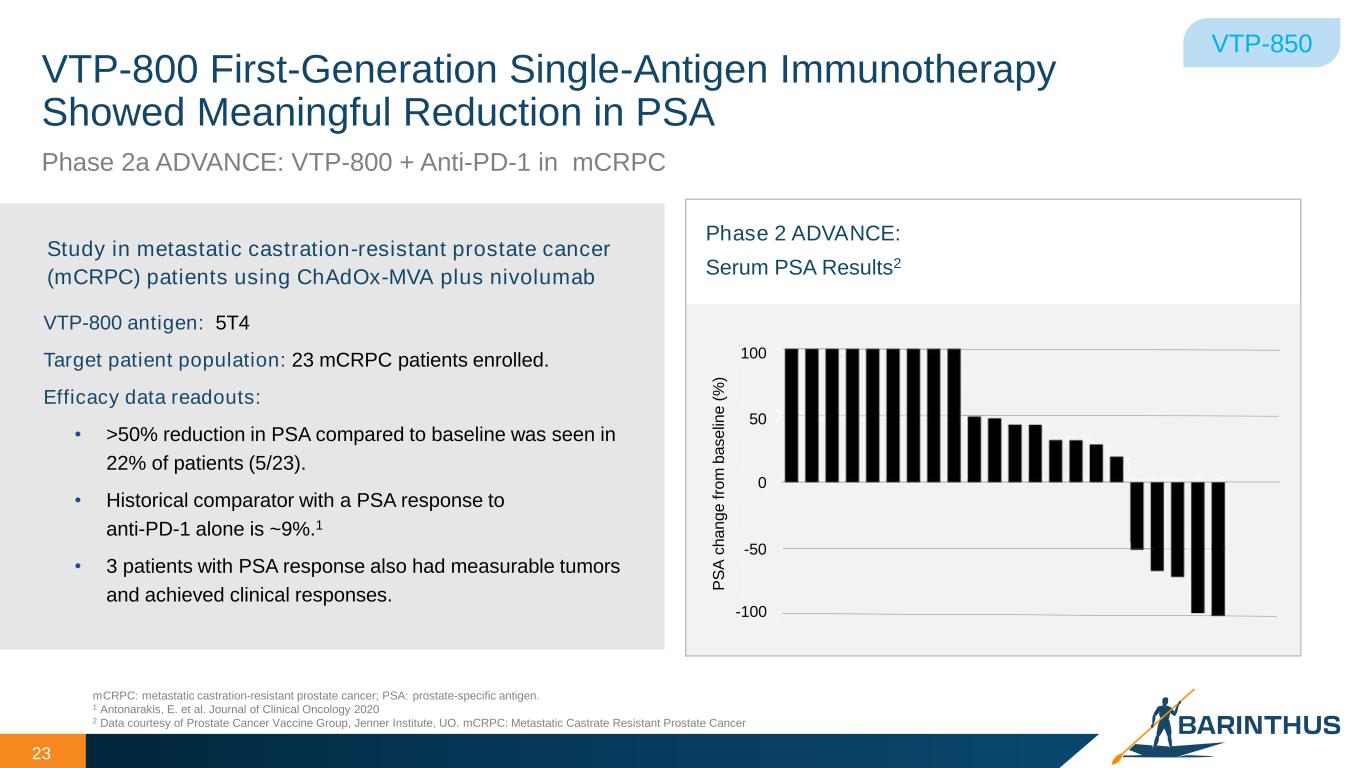
VTP-800 First-Generation Single-Antigen Immunotherapy Showed Meaningful Reduction in PSA mCRPC: metastatic castration-resistant prostate cancer; PSA: prostate-specific antigen. 1 Antonarakis, E. et al. Journal of Clinical Oncology 2020 2 Data courtesy of Prostate Cancer Vaccine Group, Jenner Institute, UO. mCRPC: Metastatic Castrate Resistant Prostate Cancer VTP-800 antigen: 5T4 Target patient population: 23 mCRPC patients enrolled. Efficacy data readouts: • >50% reduction in PSA compared to baseline was seen in 22% of patients (5/23). • Historical comparator with a PSA response to anti-PD-1 alone is ~9%.1 • 3 patients with PSA response also had measurable tumors and achieved clinical responses. Study in metastatic castration-resistant prostate cancer (mCRPC) patients using ChAdOx-MVA plus nivolumab 100 50 0 -50 -100 P S A c h a n g e f ro m b a s e lin e ( % ) Phase 2 ADVANCE: Serum PSA Results2 23 Phase 2a ADVANCE: VTP-800 + Anti-PD-1 in mCRPC VTP-850
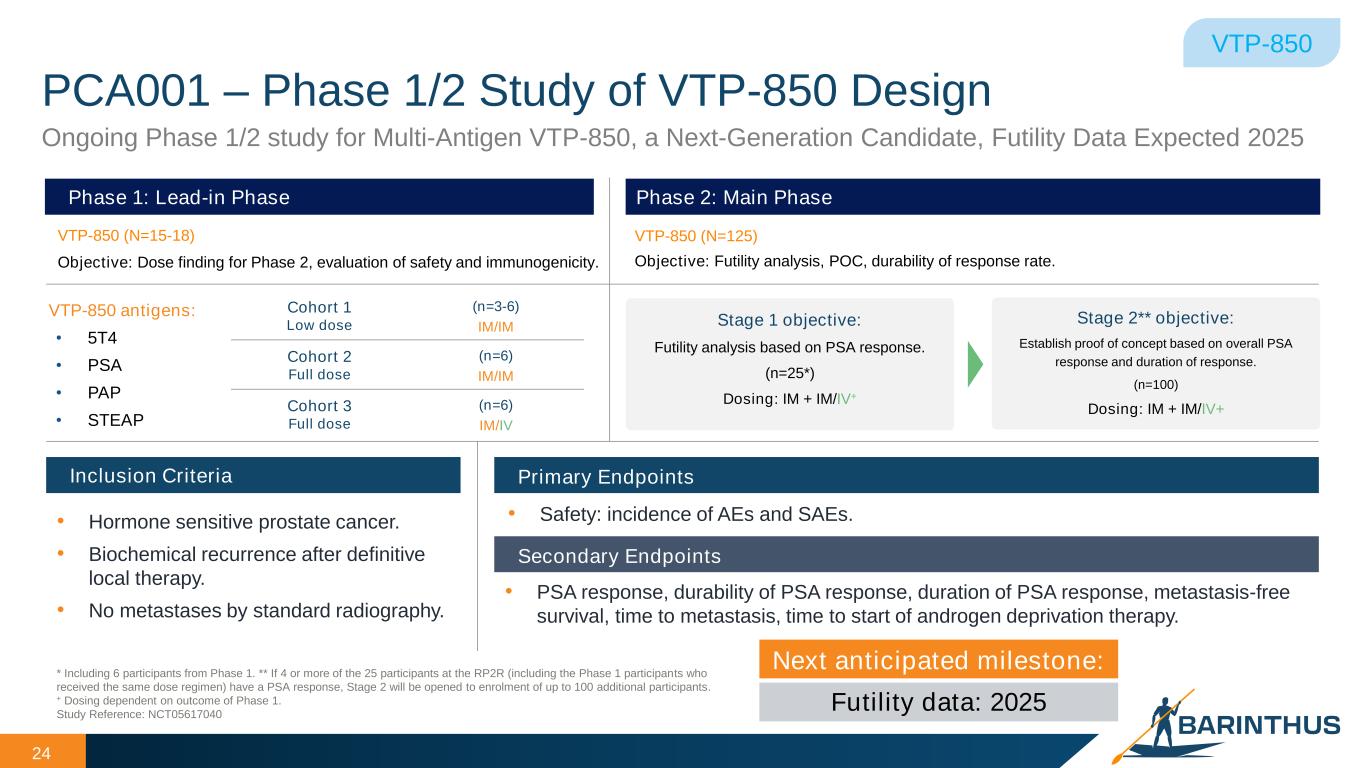
VTP-850 PCA001 – Phase 1/2 Study of VTP-850 Design • Hormone sensitive prostate cancer. • Biochemical recurrence after definitive local therapy. • No metastases by standard radiography. Inclusion Criteria Primary Endpoints Secondary Endpoints • Safety: incidence of AEs and SAEs. * Including 6 participants from Phase 1. ** If 4 or more of the 25 participants at the RP2R (including the Phase 1 participants who received the same dose regimen) have a PSA response, Stage 2 will be opened to enrolment of up to 100 additional participants. + Dosing dependent on outcome of Phase 1. Study Reference: NCT05617040 • PSA response, durability of PSA response, duration of PSA response, metastasis-free survival, time to metastasis, time to start of androgen deprivation therapy. Cohort 1 Low dose (n=3-6) IM/IM Cohort 2 Full dose (n=6) IM/IM Cohort 3 Full dose (n=6) IM/IV VTP-850 antigens: • 5T4 • PSA • PAP • STEAP Phase 1: Lead-in Phase VTP-850 (N=15-18) Objective: Dose finding for Phase 2, evaluation of safety and immunogenicity. Phase 2: Main Phase VTP-850 (N=125) Objective: Futility analysis, POC, durability of response rate. Stage 1 objective: Futility analysis based on PSA response. (n=25*) Dosing: IM + IM/IV+ Stage 2** objective: Establish proof of concept based on overall PSA response and duration of response. (n=100) Dosing: IM + IM/IV+ 24 Ongoing Phase 1/2 study for Multi-Antigen VTP-850, a Next-Generation Candidate, Futility Data Expected 2025 Next anticipated milestone: Futility data: 2025
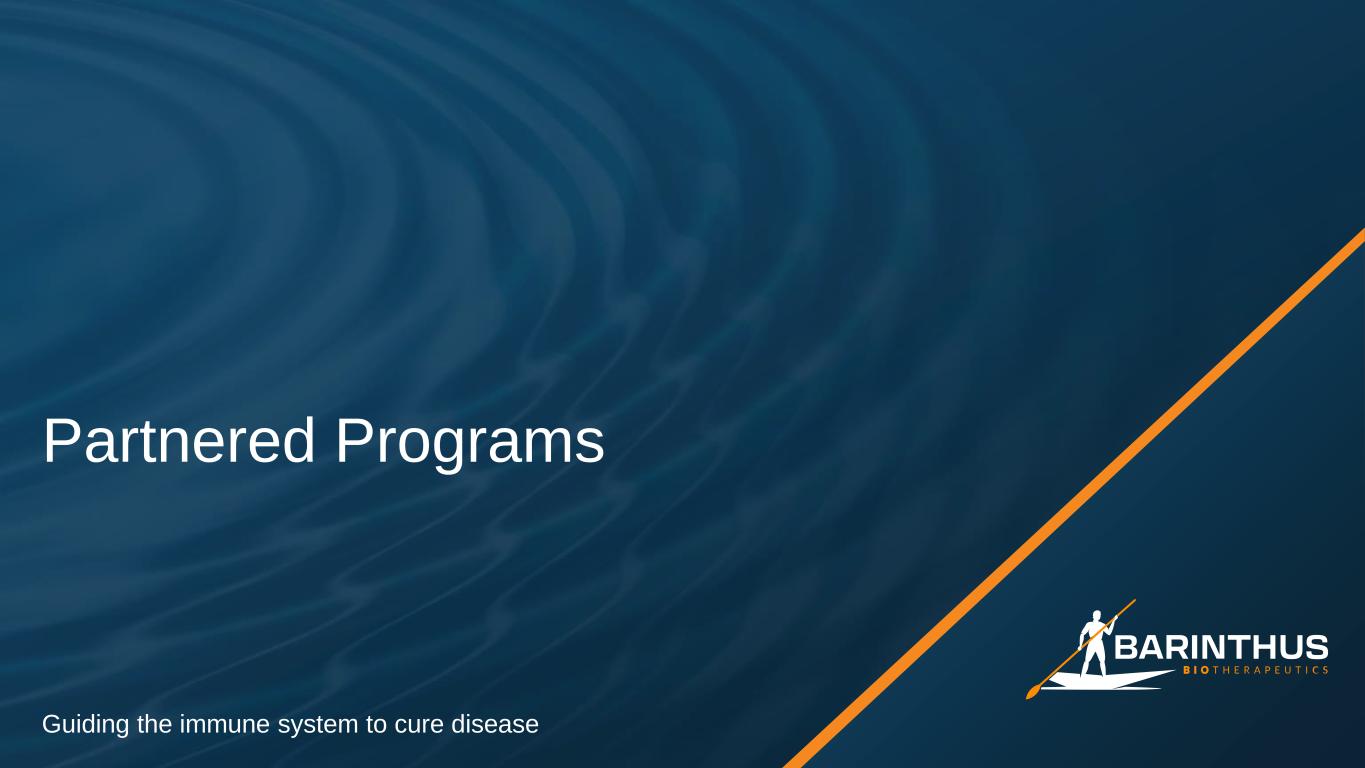
Partnered Programs Guiding the immune system to cure disease
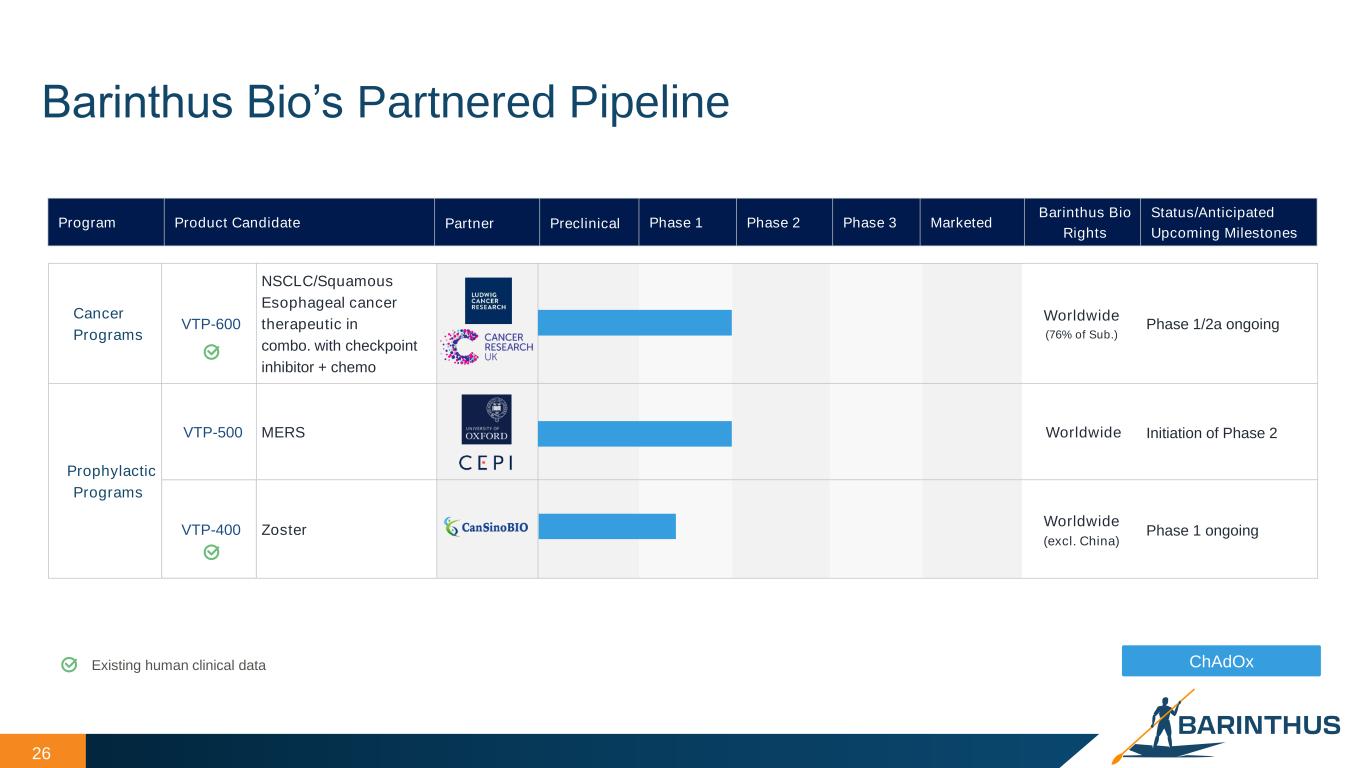
Barinthus Bio’s Partnered Pipeline 26 ChAdOx Cancer Programs VTP-600 NSCLC/Squamous Esophageal cancer therapeutic in combo. with checkpoint inhibitor + chemo Worldwide (76% of Sub.) Phase 1/2a ongoing Prophylactic Programs VTP-500 MERS Worldwide Initiation of Phase 2 VTP-400 Zoster Worldwide (excl. China) Phase 1 ongoing Program Product Candidate Partner Preclinical Phase 1 Phase 2 Phase 3 Marketed Barinthus Bio Rights Status/Anticipated Upcoming Milestones Existing human clinical data
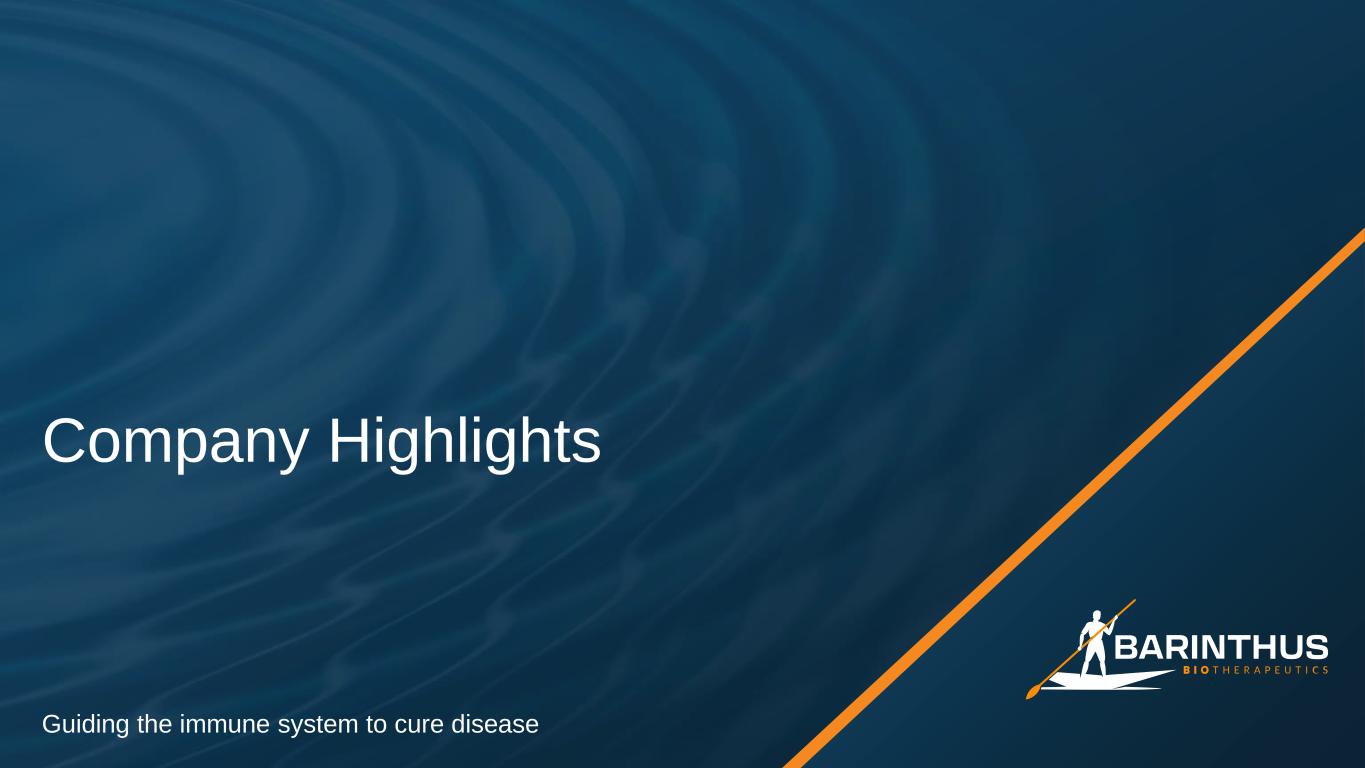
Company Highlights Guiding the immune system to cure disease
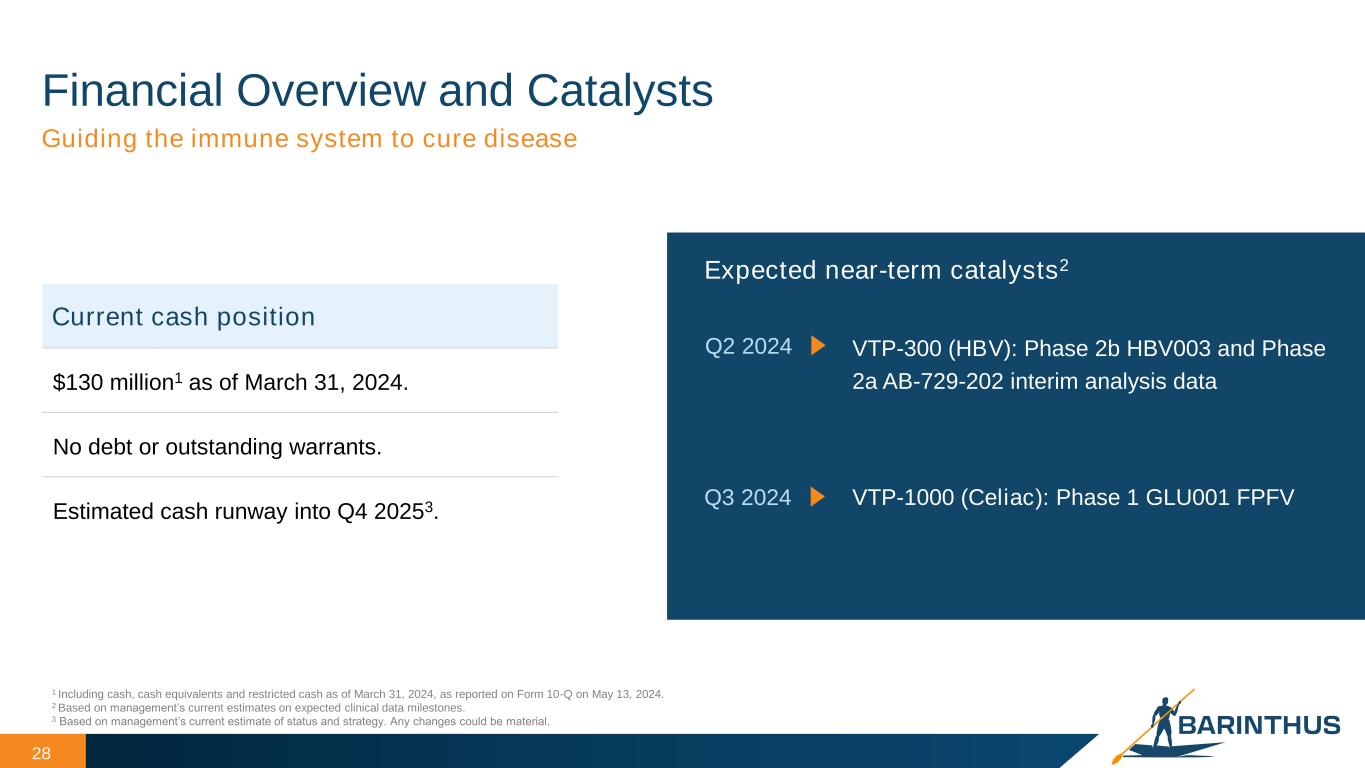
Financial Overview and Catalysts 28 Q2 2024 VTP-300 (HBV): Phase 2b HBV003 and Phase 2a AB-729-202 interim analysis data Expected near-term catalysts2 Guiding the immune system to cure disease Current cash position $130 million1 as of March 31, 2024. No debt or outstanding warrants. Estimated cash runway into Q4 20253. 1 Including cash, cash equivalents and restricted cash as of March 31, 2024, as reported on Form 10-Q on May 13, 2024. 2 Based on management’s current estimates on expected clinical data milestones. 3 Based on management’s current estimate of status and strategy. Any changes could be material. Q3 2024 VTP-1000 (Celiac): Phase 1 GLU001 FPFV
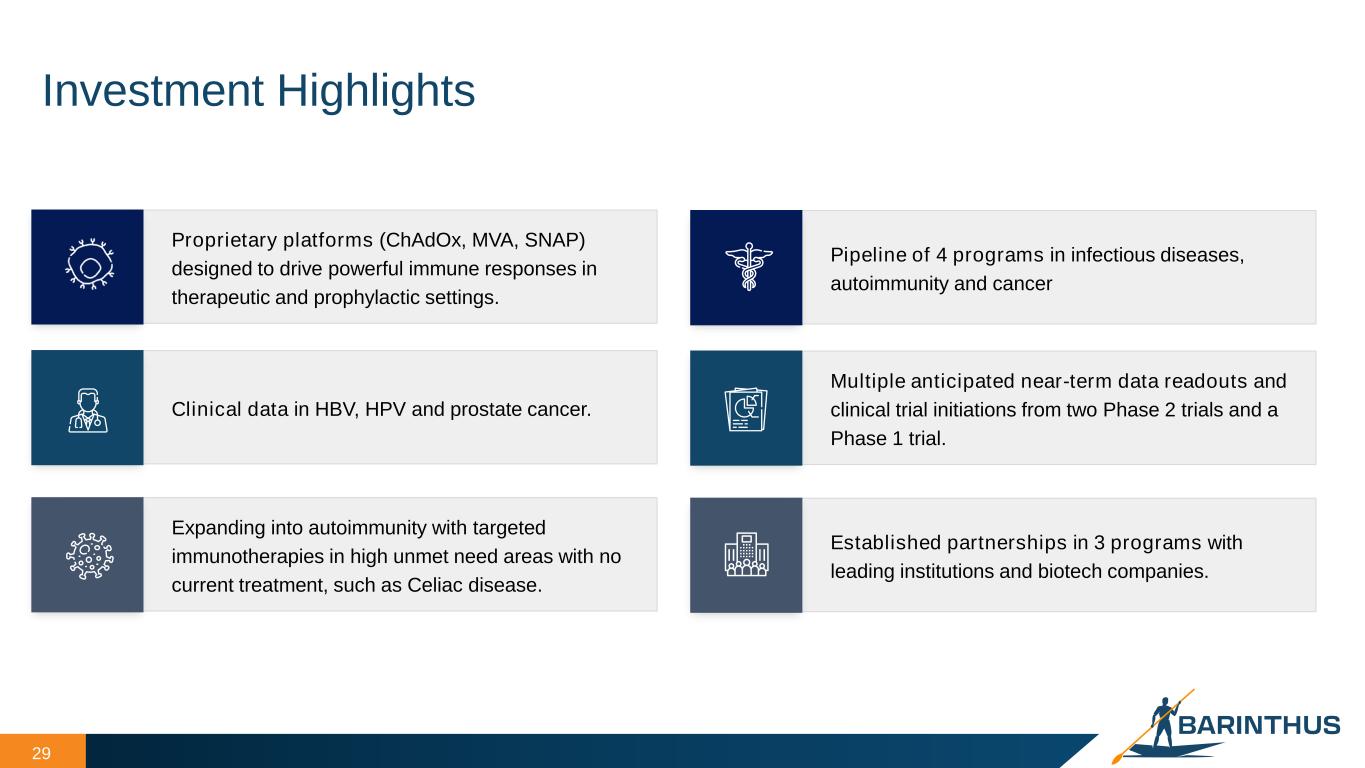
Investment Highlights 29 Expanding into autoimmunity with targeted immunotherapies in high unmet need areas with no current treatment, such as Celiac disease. Clinical data in HBV, HPV and prostate cancer. Proprietary platforms (ChAdOx, MVA, SNAP) designed to drive powerful immune responses in therapeutic and prophylactic settings. Established partnerships in 3 programs with leading institutions and biotech companies. Multiple anticipated near-term data readouts and clinical trial initiations from two Phase 2 trials and a Phase 1 trial. Pipeline of 4 programs in infectious diseases, autoimmunity and cancer
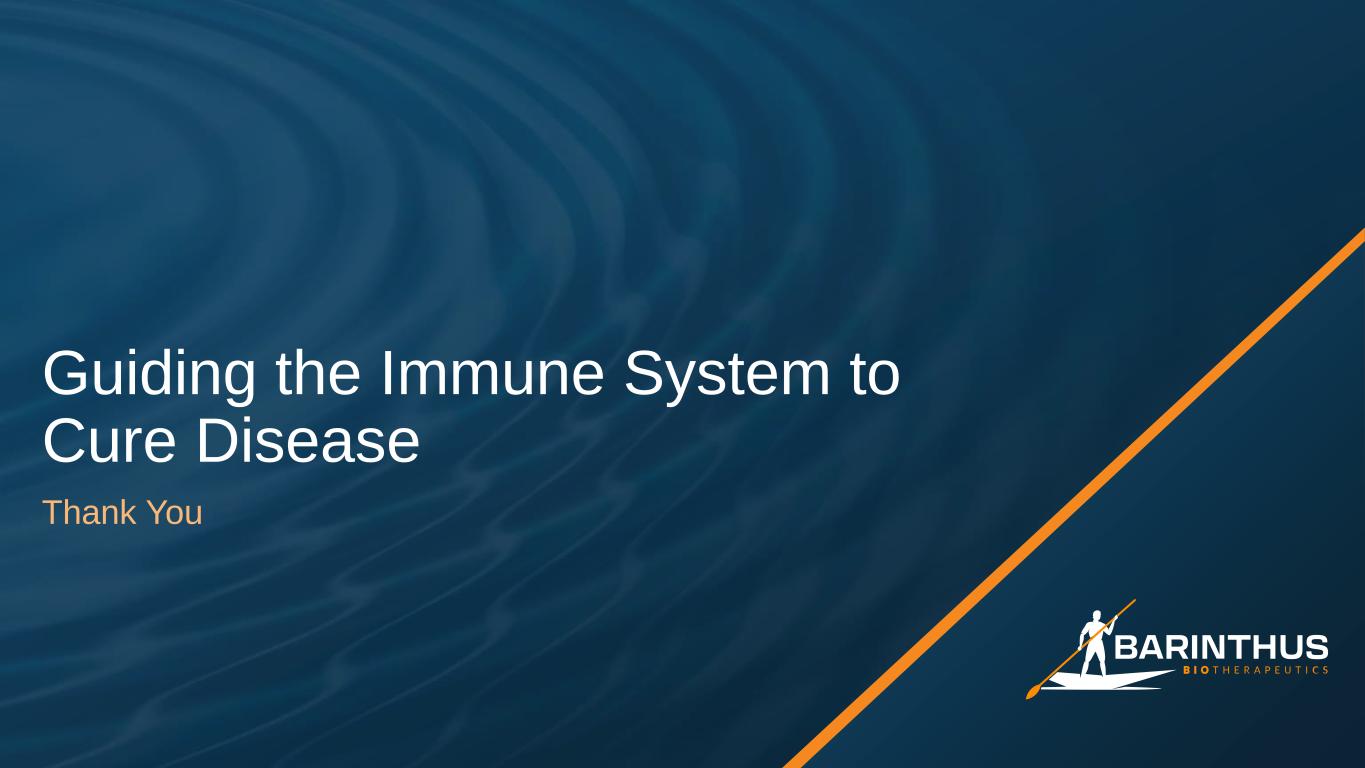
Guiding the Immune System to Cure Disease Thank You
v3.24.1.1.u2
Cover
|
May 13, 2024 |
| Document Information [Line Items] |
|
| Document Type |
8-K
|
| Document Period End Date |
May 13, 2024
|
| Entity Registrant Name |
BARINTHUS BIOTHERAPEUTICS PLC
|
| Entity Incorporation, State or Country Code |
X0
|
| Entity File Number |
001-40367
|
| Entity Tax Identification Number |
00-0000000
|
| Entity Address, Address Line One |
Barinthus Biotherapeutics plc
|
| Entity Address, Address Line Two |
Unit 6-10
|
| Entity Address, Address Line Three |
Zeus Building Rutherford Avenue
|
| Entity Address, City or Town |
Harwell, Didcot
|
| Entity Address, Postal Zip Code |
OX11 0DF
|
| Entity Address, Country |
GB
|
| City Area Code |
+44 (0)
|
| Local Phone Number |
1865 818 808
|
| Written Communications |
false
|
| Soliciting Material |
false
|
| Pre-commencement Tender Offer |
false
|
| Pre-commencement Issuer Tender Offer |
false
|
| Entity Emerging Growth Company |
true
|
| Entity Ex Transition Period |
false
|
| Amendment Flag |
false
|
| Entity Central Index Key |
0001828185
|
| American Depositary Shares |
|
| Document Information [Line Items] |
|
| Title of 12(b) Security |
American Depositary Shares
|
| Trading Symbol |
BRNS
|
| Security Exchange Name |
NASDAQ
|
| Ordinary Shares |
|
| Document Information [Line Items] |
|
| Title of 12(b) Security |
Ordinary shares, nominal value £0.000025 per share*
|
| X |
- DefinitionBoolean flag that is true when the XBRL content amends previously-filed or accepted submission.
| Name: |
dei_AmendmentFlag |
| Namespace Prefix: |
dei_ |
| Data Type: |
xbrli:booleanItemType |
| Balance Type: |
na |
| Period Type: |
duration |
|
| X |
- DefinitionFor the EDGAR submission types of Form 8-K: the date of the report, the date of the earliest event reported; for the EDGAR submission types of Form N-1A: the filing date; for all other submission types: the end of the reporting or transition period. The format of the date is YYYY-MM-DD.
| Name: |
dei_DocumentPeriodEndDate |
| Namespace Prefix: |
dei_ |
| Data Type: |
xbrli:dateItemType |
| Balance Type: |
na |
| Period Type: |
duration |
|
| X |
- DefinitionThe type of document being provided (such as 10-K, 10-Q, 485BPOS, etc). The document type is limited to the same value as the supporting SEC submission type, or the word 'Other'.
| Name: |
dei_DocumentType |
| Namespace Prefix: |
dei_ |
| Data Type: |
dei:submissionTypeItemType |
| Balance Type: |
na |
| Period Type: |
duration |
|
| X |
- DefinitionAddress Line 1 such as Attn, Building Name, Street Name
| Name: |
dei_EntityAddressAddressLine1 |
| Namespace Prefix: |
dei_ |
| Data Type: |
xbrli:normalizedStringItemType |
| Balance Type: |
na |
| Period Type: |
duration |
|
| X |
- DefinitionAddress Line 2 such as Street or Suite number
| Name: |
dei_EntityAddressAddressLine2 |
| Namespace Prefix: |
dei_ |
| Data Type: |
xbrli:normalizedStringItemType |
| Balance Type: |
na |
| Period Type: |
duration |
|
| X |
- DefinitionAddress Line 3 such as an Office Park
| Name: |
dei_EntityAddressAddressLine3 |
| Namespace Prefix: |
dei_ |
| Data Type: |
xbrli:normalizedStringItemType |
| Balance Type: |
na |
| Period Type: |
duration |
|
| X |
- Definition
+ References
+ Details
| Name: |
dei_EntityAddressCityOrTown |
| Namespace Prefix: |
dei_ |
| Data Type: |
xbrli:normalizedStringItemType |
| Balance Type: |
na |
| Period Type: |
duration |
|
| X |
- DefinitionISO 3166-1 alpha-2 country code.
| Name: |
dei_EntityAddressCountry |
| Namespace Prefix: |
dei_ |
| Data Type: |
dei:countryCodeItemType |
| Balance Type: |
na |
| Period Type: |
duration |
|
| X |
- DefinitionCode for the postal or zip code
| Name: |
dei_EntityAddressPostalZipCode |
| Namespace Prefix: |
dei_ |
| Data Type: |
xbrli:normalizedStringItemType |
| Balance Type: |
na |
| Period Type: |
duration |
|
| X |
- DefinitionA unique 10-digit SEC-issued value to identify entities that have filed disclosures with the SEC. It is commonly abbreviated as CIK. Reference 1: http://www.xbrl.org/2003/role/presentationRef
-Publisher SEC
-Name Exchange Act
-Number 240
-Section 12
-Subsection b-2
| Name: |
dei_EntityCentralIndexKey |
| Namespace Prefix: |
dei_ |
| Data Type: |
dei:centralIndexKeyItemType |
| Balance Type: |
na |
| Period Type: |
duration |
|
| X |
- DefinitionIndicate if registrant meets the emerging growth company criteria. Reference 1: http://www.xbrl.org/2003/role/presentationRef
-Publisher SEC
-Name Exchange Act
-Number 240
-Section 12
-Subsection b-2
| Name: |
dei_EntityEmergingGrowthCompany |
| Namespace Prefix: |
dei_ |
| Data Type: |
xbrli:booleanItemType |
| Balance Type: |
na |
| Period Type: |
duration |
|
| X |
- DefinitionCommission file number. The field allows up to 17 characters. The prefix may contain 1-3 digits, the sequence number may contain 1-8 digits, the optional suffix may contain 1-4 characters, and the fields are separated with a hyphen.
| Name: |
dei_EntityFileNumber |
| Namespace Prefix: |
dei_ |
| Data Type: |
dei:fileNumberItemType |
| Balance Type: |
na |
| Period Type: |
duration |
|
| X |
- DefinitionTwo-character EDGAR code representing the state or country of incorporation.
| Name: |
dei_EntityIncorporationStateCountryCode |
| Namespace Prefix: |
dei_ |
| Data Type: |
dei:edgarStateCountryItemType |
| Balance Type: |
na |
| Period Type: |
duration |
|
| X |
- DefinitionThe exact name of the entity filing the report as specified in its charter, which is required by forms filed with the SEC. Reference 1: http://www.xbrl.org/2003/role/presentationRef
-Publisher SEC
-Name Exchange Act
-Number 240
-Section 12
-Subsection b-2
| Name: |
dei_EntityRegistrantName |
| Namespace Prefix: |
dei_ |
| Data Type: |
xbrli:normalizedStringItemType |
| Balance Type: |
na |
| Period Type: |
duration |
|
| X |
- DefinitionThe Tax Identification Number (TIN), also known as an Employer Identification Number (EIN), is a unique 9-digit value assigned by the IRS. Reference 1: http://www.xbrl.org/2003/role/presentationRef
-Publisher SEC
-Name Exchange Act
-Number 240
-Section 12
-Subsection b-2
| Name: |
dei_EntityTaxIdentificationNumber |
| Namespace Prefix: |
dei_ |
| Data Type: |
dei:employerIdItemType |
| Balance Type: |
na |
| Period Type: |
duration |
|
| X |
- DefinitionLocal phone number for entity.
| Name: |
dei_LocalPhoneNumber |
| Namespace Prefix: |
dei_ |
| Data Type: |
xbrli:normalizedStringItemType |
| Balance Type: |
na |
| Period Type: |
duration |
|
| X |
- DefinitionBoolean flag that is true when the Form 8-K filing is intended to satisfy the filing obligation of the registrant as pre-commencement communications pursuant to Rule 13e-4(c) under the Exchange Act. Reference 1: http://www.xbrl.org/2003/role/presentationRef
-Publisher SEC
-Name Exchange Act
-Number 240
-Section 13e
-Subsection 4c
| Name: |
dei_PreCommencementIssuerTenderOffer |
| Namespace Prefix: |
dei_ |
| Data Type: |
xbrli:booleanItemType |
| Balance Type: |
na |
| Period Type: |
duration |
|
| X |
- DefinitionBoolean flag that is true when the Form 8-K filing is intended to satisfy the filing obligation of the registrant as pre-commencement communications pursuant to Rule 14d-2(b) under the Exchange Act. Reference 1: http://www.xbrl.org/2003/role/presentationRef
-Publisher SEC
-Name Exchange Act
-Number 240
-Section 14d
-Subsection 2b
| Name: |
dei_PreCommencementTenderOffer |
| Namespace Prefix: |
dei_ |
| Data Type: |
xbrli:booleanItemType |
| Balance Type: |
na |
| Period Type: |
duration |
|
| X |
- DefinitionTitle of a 12(b) registered security. Reference 1: http://www.xbrl.org/2003/role/presentationRef
-Publisher SEC
-Name Exchange Act
-Number 240
-Section 12
-Subsection b
| Name: |
dei_Security12bTitle |
| Namespace Prefix: |
dei_ |
| Data Type: |
dei:securityTitleItemType |
| Balance Type: |
na |
| Period Type: |
duration |
|
| X |
- DefinitionName of the Exchange on which a security is registered. Reference 1: http://www.xbrl.org/2003/role/presentationRef
-Publisher SEC
-Name Exchange Act
-Number 240
-Section 12
-Subsection d1-1
| Name: |
dei_SecurityExchangeName |
| Namespace Prefix: |
dei_ |
| Data Type: |
dei:edgarExchangeCodeItemType |
| Balance Type: |
na |
| Period Type: |
duration |
|
| X |
- DefinitionBoolean flag that is true when the Form 8-K filing is intended to satisfy the filing obligation of the registrant as soliciting material pursuant to Rule 14a-12 under the Exchange Act. Reference 1: http://www.xbrl.org/2003/role/presentationRef
-Publisher SEC
-Name Exchange Act
-Section 14a
-Number 240
-Subsection 12
| Name: |
dei_SolicitingMaterial |
| Namespace Prefix: |
dei_ |
| Data Type: |
xbrli:booleanItemType |
| Balance Type: |
na |
| Period Type: |
duration |
|
| X |
- DefinitionTrading symbol of an instrument as listed on an exchange.
| Name: |
dei_TradingSymbol |
| Namespace Prefix: |
dei_ |
| Data Type: |
dei:tradingSymbolItemType |
| Balance Type: |
na |
| Period Type: |
duration |
|
| X |
- DefinitionBoolean flag that is true when the Form 8-K filing is intended to satisfy the filing obligation of the registrant as written communications pursuant to Rule 425 under the Securities Act. Reference 1: http://www.xbrl.org/2003/role/presentationRef
-Publisher SEC
-Name Securities Act
-Number 230
-Section 425
| Name: |
dei_WrittenCommunications |
| Namespace Prefix: |
dei_ |
| Data Type: |
xbrli:booleanItemType |
| Balance Type: |
na |
| Period Type: |
duration |
|
| X |
- Details
| Name: |
us-gaap_StatementClassOfStockAxis=brns_AmericanDepositarySharesMember |
| Namespace Prefix: |
|
| Data Type: |
na |
| Balance Type: |
|
| Period Type: |
|
|
| X |
- Details
| Name: |
us-gaap_StatementClassOfStockAxis=us-gaap_CommonStockMember |
| Namespace Prefix: |
|
| Data Type: |
na |
| Balance Type: |
|
| Period Type: |
|
|
Barinthus Biotherapeutics (NASDAQ:BRNS)
Gráfica de Acción Histórica
De Abr 2024 a May 2024

Barinthus Biotherapeutics (NASDAQ:BRNS)
Gráfica de Acción Histórica
De May 2023 a May 2024
